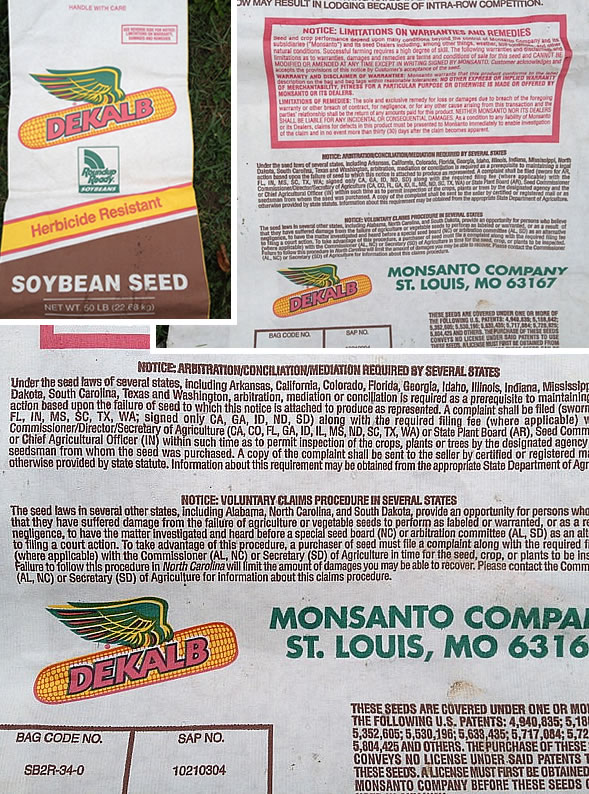 No Place Like It
No Place Like It
 Last week on July 4th, I celebrated Independence Day in an unusual manner. Having just finished packing shares for Thursday’s delivery, I went on my first ever whale watching adventure, right here in Monterey Bay. Now I easily get seasick, so I never would have initiated an outing like this, however our good friends Miriam and Harley Goldberg learned that blue whales were being sighted in the Bay, jumped on some reservations, then convinced me to leave with them on a boat from the Moss Landing Harbor, a mere 20 minutes from the farm. Armed with candied ginger and a special anti-seasickness wristband we headed into the Bay. We weren’t out long before we spotted a huge vertical water spout, followed by the smooth long blue-grey ridge of a whale’s back. The moment was brief; the whale broke the water’s surface, gliding effortlessly, then disappeared again. Shortly after the first spout we spotted another… equally impressive, easily 20 ft high. The marine biologist on board confirmed these were two adult blue whales, actively feeding on their favorite food: krill, a small shrimp-like zooplankton, currently abundant in the nutrient-rich cold water upwelling from the deep marine canyons of Monterey Bay. It’s rare, we were told, to see blue whales so close to shore. As we followed these giants for the next hour, surfacing every 5-10 minutes for a breath before plunging down to scoop up more krill, I thought about just how amazing this all was. First, that I wasn’t getting sick; second – and more importantly – realizing how fortunate I am to be able to farm in such close proximity to these rich ocean waters — unique, in that their moderating effect on our coastal climate is what allows us to grow such a diversity of crops year-round. The Monterey Bay really is one very special ecosystem, a region where land and ocean are intricately linked, offering up an abundance of rich, nourishing food.
Last week on July 4th, I celebrated Independence Day in an unusual manner. Having just finished packing shares for Thursday’s delivery, I went on my first ever whale watching adventure, right here in Monterey Bay. Now I easily get seasick, so I never would have initiated an outing like this, however our good friends Miriam and Harley Goldberg learned that blue whales were being sighted in the Bay, jumped on some reservations, then convinced me to leave with them on a boat from the Moss Landing Harbor, a mere 20 minutes from the farm. Armed with candied ginger and a special anti-seasickness wristband we headed into the Bay. We weren’t out long before we spotted a huge vertical water spout, followed by the smooth long blue-grey ridge of a whale’s back. The moment was brief; the whale broke the water’s surface, gliding effortlessly, then disappeared again. Shortly after the first spout we spotted another… equally impressive, easily 20 ft high. The marine biologist on board confirmed these were two adult blue whales, actively feeding on their favorite food: krill, a small shrimp-like zooplankton, currently abundant in the nutrient-rich cold water upwelling from the deep marine canyons of Monterey Bay. It’s rare, we were told, to see blue whales so close to shore. As we followed these giants for the next hour, surfacing every 5-10 minutes for a breath before plunging down to scoop up more krill, I thought about just how amazing this all was. First, that I wasn’t getting sick; second – and more importantly – realizing how fortunate I am to be able to farm in such close proximity to these rich ocean waters — unique, in that their moderating effect on our coastal climate is what allows us to grow such a diversity of crops year-round. The Monterey Bay really is one very special ecosystem, a region where land and ocean are intricately linked, offering up an abundance of rich, nourishing food.
There I was, seemingly only moments ago, on land, at the farm, packing CSA shares; then I was standing on the bow of a boat, watching the largest animals ever known to have lived on our planet scoop up tons of krill in one of the world’s richest and most diverse marine environments – the Monterey Bay Marine Sanctuary. In farming, we easily get caught up in the economics of food production, often ignoring the importance of balancing the diverse relationships between the cultivated and non-cultivated environments around us. Here on the farm our fields are surrounded by native habitat, plants and animals; the boundaries between domesticated land and wilderness are easily blurred. Most of the time this means we are a source of food for a diverse community of living creatures (humans included), a community I like to believe can coexist. It also means sometimes we have deer munching on our green beans, coyotes catching a few of our chickens or birds pecking on our fruit.
Just like the Monterey Bay marine environment needs protecting, so too do the rich agricultural lands surrounding the Bay need protecting – primarily from encroaching urban development. Well managed ranches and farms are vital to helping support wildlife habitat, healthy soils, local food supplies, and recreational and scenic resources. Equally important is that agricultural land be protected, so that future generations of family farmers and ranchers can continue farming and support a healthy local economy based on healthy ties to the land and their agrarian values. So thank you all for supporting this farm, as well as so many other local farmers and producers who supply us with their locally grown crops and farm products. It makes our work so much more meaningful. I like to believe that food is a vehicle for creating a more secure and stable future, one where we celebrate our interdependence rather than our independence.
Happy belated 4th of July – Tom
 Seeds of Change: Our Food Chain in Peril
Seeds of Change: Our Food Chain in Peril
 In nature it is inconceivable that genetic material (DNA) from one organism is inserted into a different species. Imagine exchanging genes from a rat or fish with those of a tomato. This is nothing unusual, however, with today’s DNA technology. GMO corn and soybeans, for example, are grown on millions of acres across the country, largely unchecked as to whether they are harmful to the environment or human health. As with any life form, once established in its new surroundings, it can replicate, change and spread. The genie is out of the bottle now, difficult or impossible to stuff back.
In nature it is inconceivable that genetic material (DNA) from one organism is inserted into a different species. Imagine exchanging genes from a rat or fish with those of a tomato. This is nothing unusual, however, with today’s DNA technology. GMO corn and soybeans, for example, are grown on millions of acres across the country, largely unchecked as to whether they are harmful to the environment or human health. As with any life form, once established in its new surroundings, it can replicate, change and spread. The genie is out of the bottle now, difficult or impossible to stuff back. sold in grocery stores in California, just like they’re labeled for consumers in over 60 countries around the world (see typical EU label, at right). Big pesticide companies are spending one million dollars a day to confuse California voters about Prop 37. Monsanto and DuPont are the biggest donors, with BASF, Bayer, Dow and Syngenta amounting to over $20 million. Another nearly $20 million is coming from PepsiCo, Nestle, CocaCola and friends. Corporate greed and economic profiteering, not the common public good, is behind the no-vote for Proposition 37.
sold in grocery stores in California, just like they’re labeled for consumers in over 60 countries around the world (see typical EU label, at right). Big pesticide companies are spending one million dollars a day to confuse California voters about Prop 37. Monsanto and DuPont are the biggest donors, with BASF, Bayer, Dow and Syngenta amounting to over $20 million. Another nearly $20 million is coming from PepsiCo, Nestle, CocaCola and friends. Corporate greed and economic profiteering, not the common public good, is behind the no-vote for Proposition 37.
 Crop & Field Notes: Frosty Fields, December 2013
Crop & Field Notes: Frosty Fields, December 2013
The past week has been a frosty one indeed. Take a walk through the fields with us to see how they look.
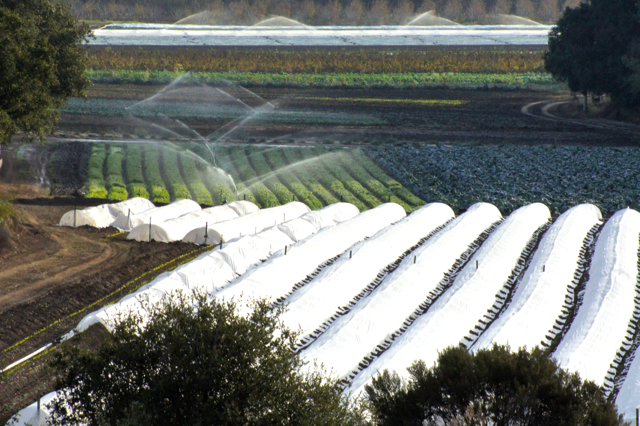
The rows in the foreground are covered in “remay” tunnels that protect crops, in this case lettuce seedlings, from frost. The rows to the right in the middle field are planted with cauliflower, while the rows on the left, being sprinkled, are planted with radishes and Japanese turnips.
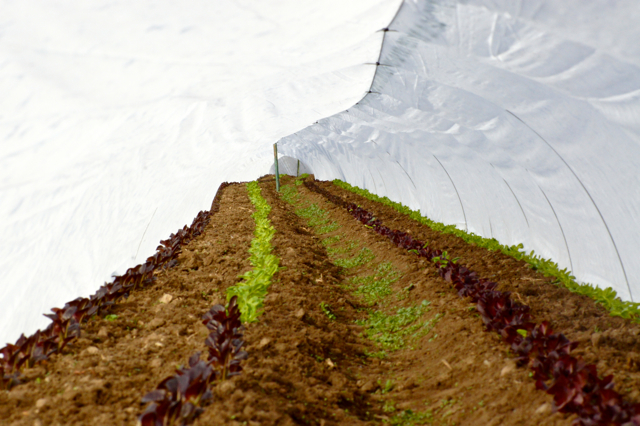
Well protected from damaging frost, the lettuce seedlings under the remay are thriving .
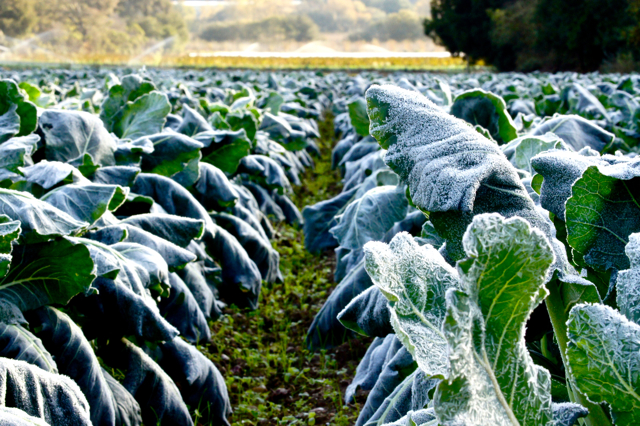
More mature cauliflower plants were sprinkled the evening before since water remaining on the leaves protects the plants by absorbing cold, creating an insulating blanket of ice crystals which keeps the plant’s temperature from falling too low.
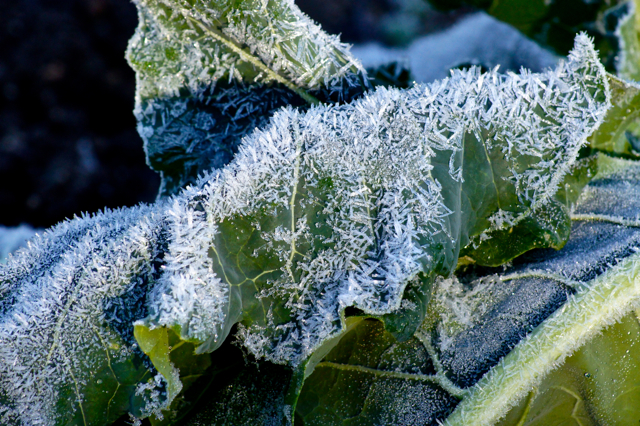
This close-up, and the one below, of the cauliflower leaves shows the patterns the frost creates.
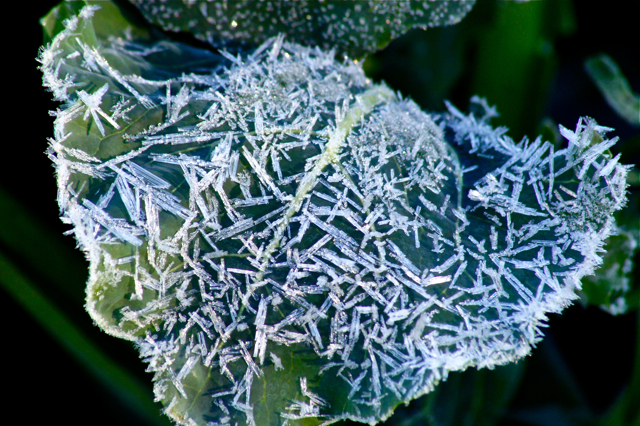
The cold weather slows growth and the plants create more sugars, which freeze at lower temps, to protect themselves. This is why winter veggies often taste sweeter than summer ones.

It got cold enough to freeze some standing water in a low patch of the road.
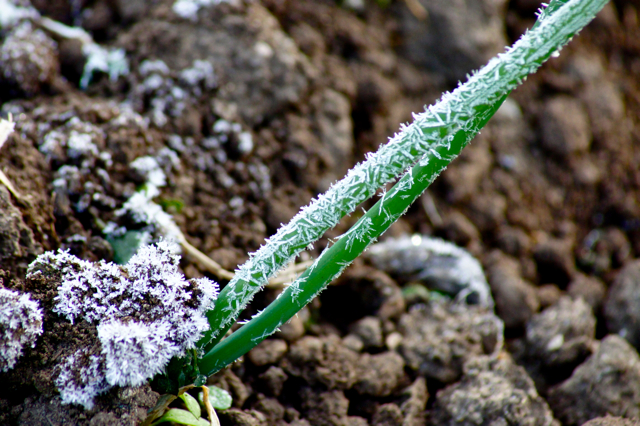
This garlic shoot is doing its best to shrug off some flakes of frost.

The frost is so thick in this blackberry row it almost looks like snow.
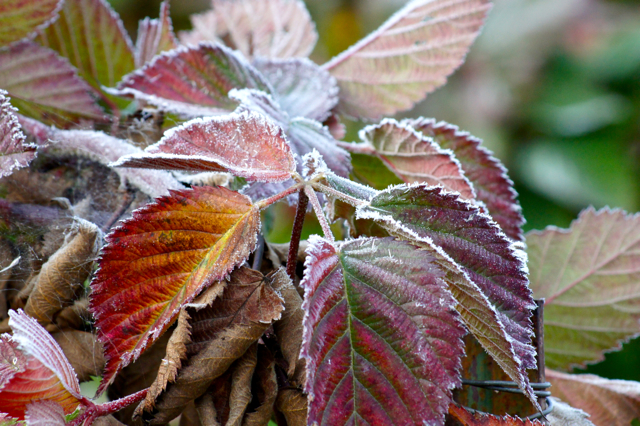
Frost rimed blackberry leaves.
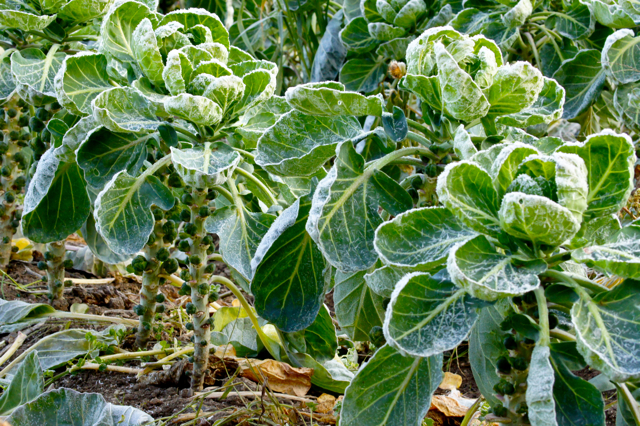
These Brussels sprouts made it through okay, and will be all the sweeter for it.
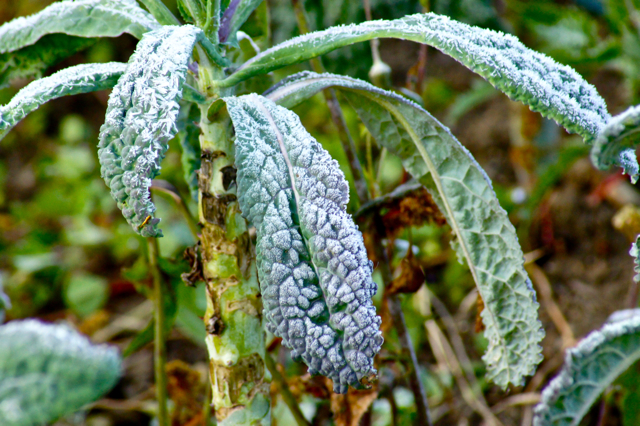
The Lacinato (Dino) Kale has its own frost blanket. Notice how the leaves have been harvested yet the plant has been left to continue to grow. The harvest is extended by leaving the plant in the ground longer.

All puffed up against the cold, this hummingbird takes a sunbath on one of the Farm’s Meyer lemon trees.
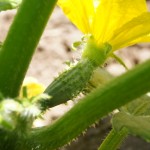 Crop & Field Notes: What’s in the Fields, August 2013
Crop & Field Notes: What’s in the Fields, August 2013
Things are always changing in the fields. From month to month, week to week, and day to day. Here’s a photo essay to keep you up to date.

Pictured here is a field of summer squash from a previous post on July 9th. It’s changed dramatically in just a few weeks.

This is the same field from the opposite direction. The squash leaves are almost completely covering the ground, and the plants are full of flowers and small squash.
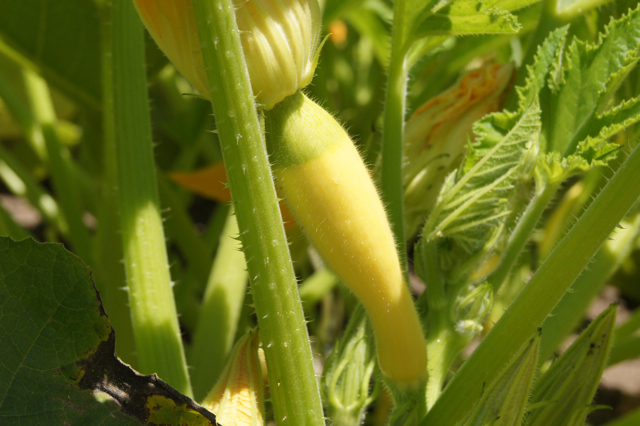
The squash are tucked in, hidden under the leaves at the base of the plants. They grow quickly, and this particular squash will be ready for harvest in just a few days

This zucchini is growing in a field nearby the one above.
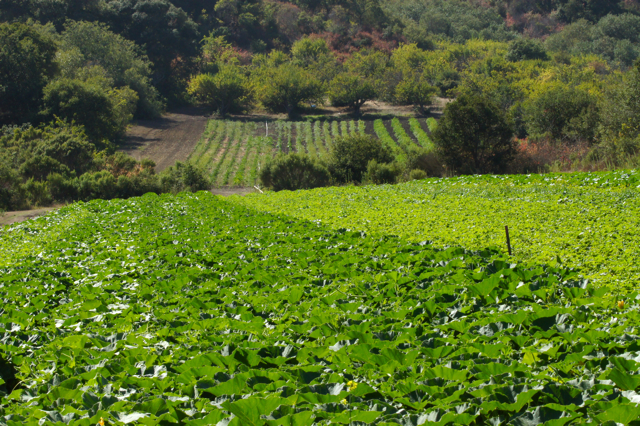
Lush and green, this is a field full of winter squash and cucumber plants.

While the winter squash are only just beginning to produce blossoms, the cucumbers are already on their way to being ready for harvest. Here’s a small pickling cucumber that will be in someone’s box soon.

The cucumber above just needs to reach this size for harvest.
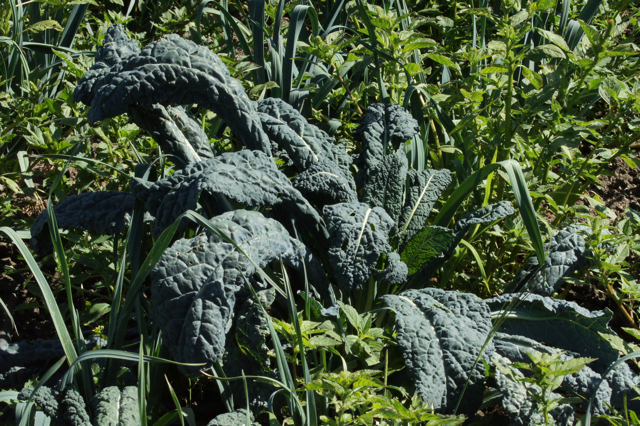
Plants have wills of their own. This dino kale, looking healthy and strong, is a volunteer that came up in the middle of a field of leeks.

Bees bees bees. We can never have enough of them here on the farm. Whether they are feeding on an invasive thistle…
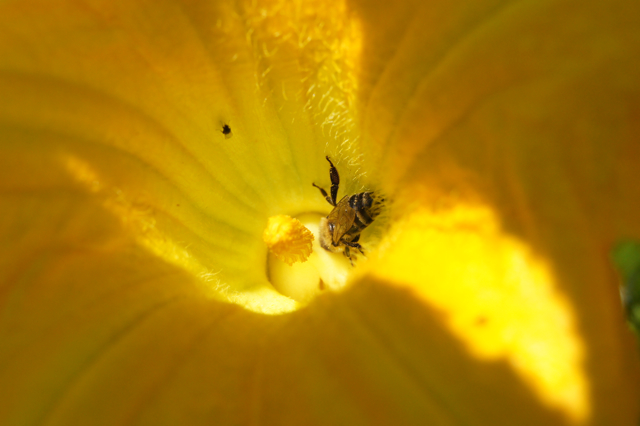
…pollinating a squash blossom…
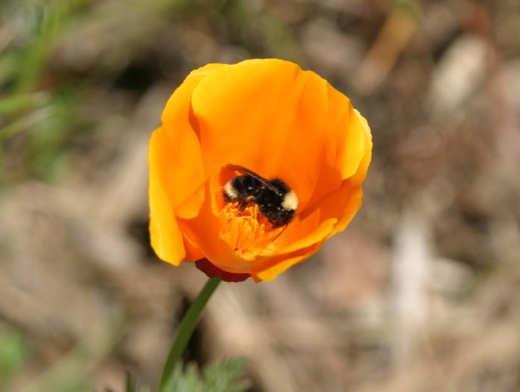
…visiting a California Poppy…

…or making sure our blackberry vines produce berries, we love them.
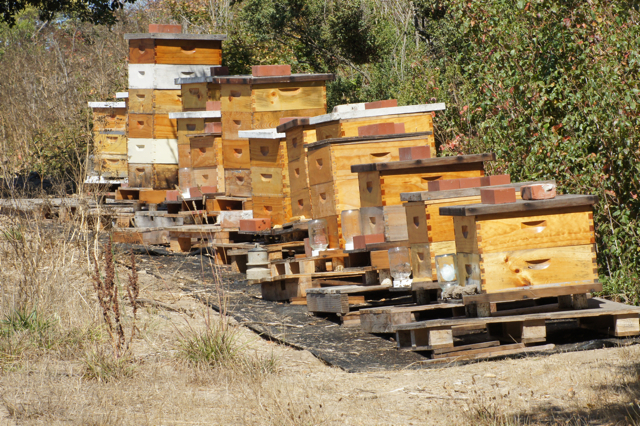
In fact, there are now some permanent hives on the farm. These were placed here, and are managed by, friend-of-the-farm Patrick W.

Summer is a colorful time on the farm. Even the poison oak puts on its red dress.

Much preferred, though, is the red of our dry-farmed Early Girl tomatoes. Are you ready for the U-Harvest on Saturday, Aug 24th?

While the Early Girls are already being put in the shares, with the August heat upon us it won’t be long before these Heirloom tomatoes will be ready for harvest, too.

In contrast to last year, this season has been a good one for our cane berries. Recently harvested, this blackberry row still has lots of ripening berries.
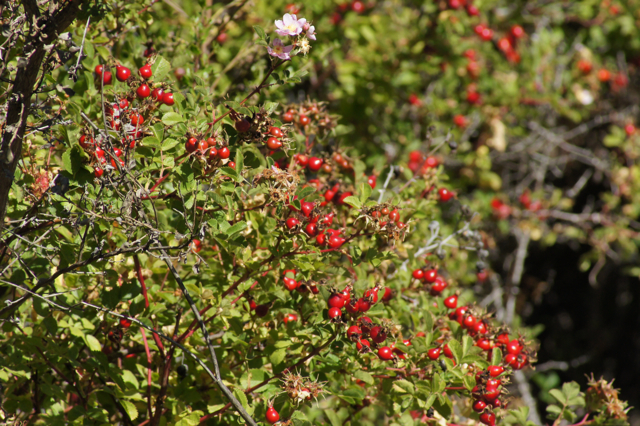
There are many patches of wild roses on the farm. This time of year, wild rose hips are adding their own bit of red to the landscape. Cup of tea anyone?
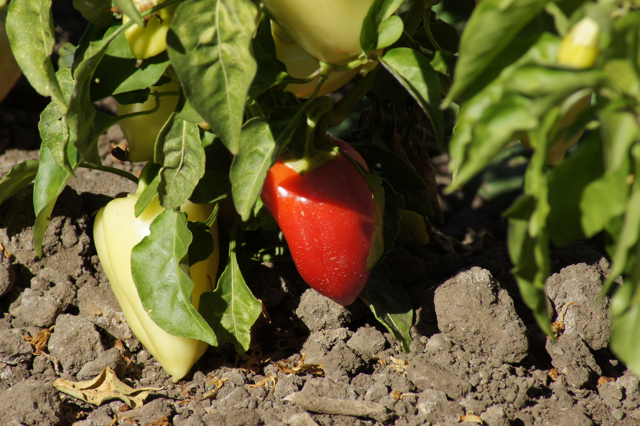
Sweet Lipstick Peppers peek out from under leaves in the pepper fields.
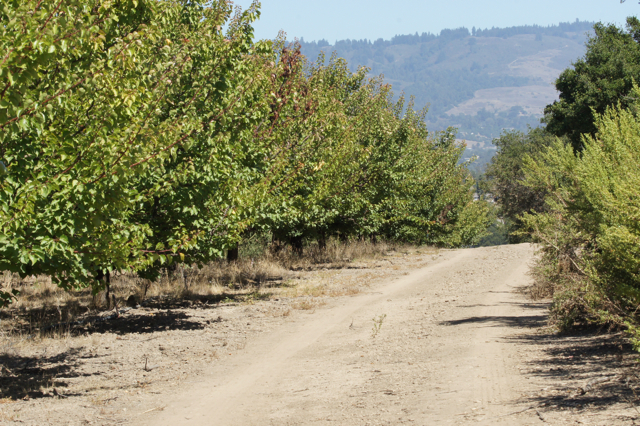
Though the apricot trees no longer have any fruit on them…

…they still bear small jewels. Protective sap balls form where a branch’s bark cracked or sustained some kind of damage.

Our Concord grape vines have been quietly working away…

…creating jewels of their own that will be ready for harvest in late September.
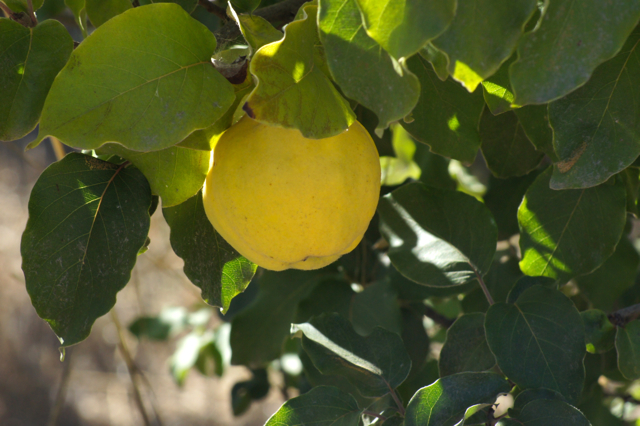
An obscure fruit, the quince are just starting to turn yellow and give off their wonderful fragrance. Difficult to use, these don’t appear in the shares very often, instead they go to Happy Girl Kitchen to be turned into quince candy and membrillo.
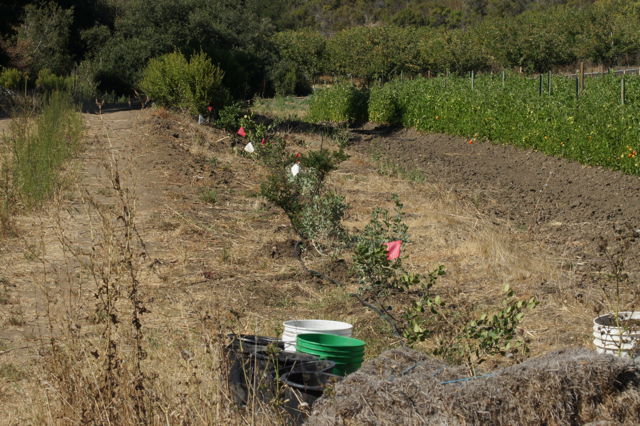
There are a number of hedgerow projects on the farm. This row was recently planted near the Heirloom tomato field.
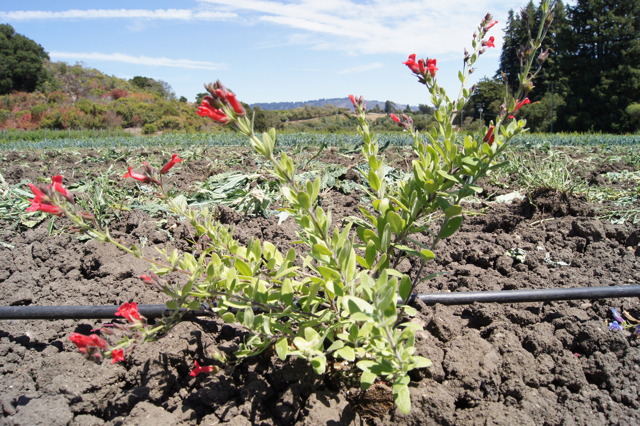
The hedgerows contain native plants, like this penstemon…
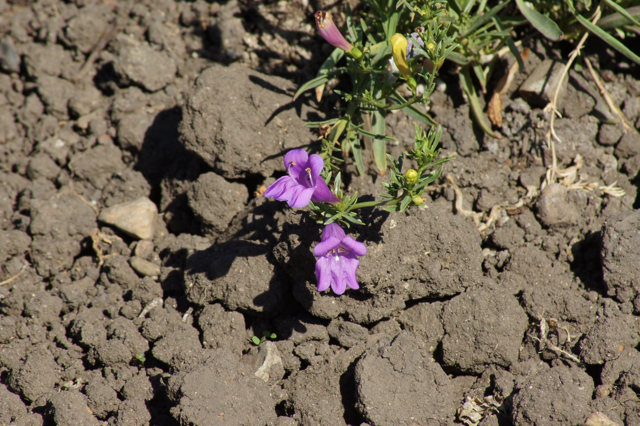
…and this other variety of penstemon, too. Their flowers are important attractors for pollinators.
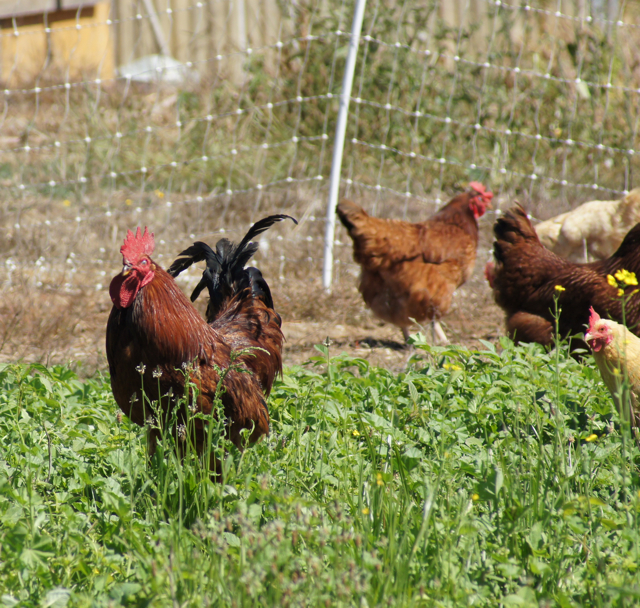
What would a farm be without animals and other wildlife. This rooster is in with one of our pastured flocks. Though hens will lay eggs without a rooster, having one can help since they announce intruders, herd or lead the hens into the coop at dusk, and dole out any tasty morsels as evenly and fairly as possible (at least, a good rooster does so).

This is one of the goat kids born earlier this year. The kids are growing fast, and they’ve already become noisy teens bleating “hello, don’t you want to feed me?” as anyone walks past their enclosure.

Our farm dog, Chella, takes it easy in the shade on a hot day. She’ll be up all night chasing away coyotes from the hens and deer from the fields, so she deserves a good rest.
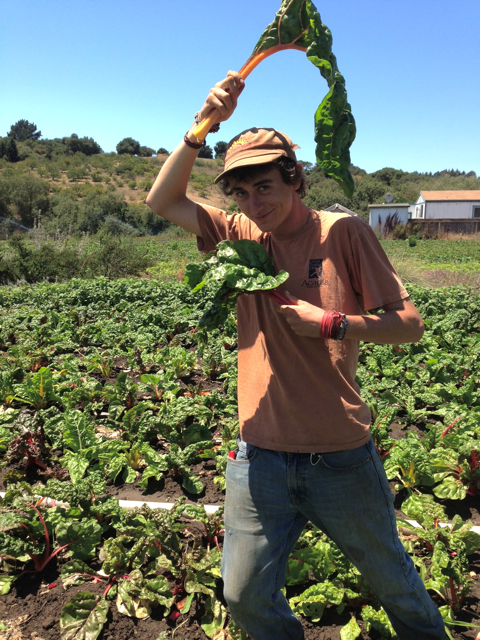
And speaking of wildlife, here’s one of our summer helpers, Noah, flying his chard flag high while doing his happy chard-dance.
Summer is a great time to visit the farm, so come on by on a Saturday to shop at our Green Valley Barn Farm Stand, walk the fields and nibble on some freshly picked produce, and take in the sights and scents.
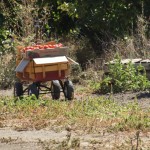 Dry-farmed Tomato U-Harvest Day – Aug 24th, 2013
Dry-farmed Tomato U-Harvest Day – Aug 24th, 2013
The pictures below express more about the fun we had last Saturday at our first Dry-farmed Tomato U-Harvest than words ever will – thank you all so much for joining us on the farm!! 🙂
Due to the high demand and interest by members and extended community, we will continue hosting Saturday Tomato U-Harvests for the next two weeks, Saturday, August 31 and Saturday, September 7 from 10:00AM – 3:00PM. (Click here for more information).
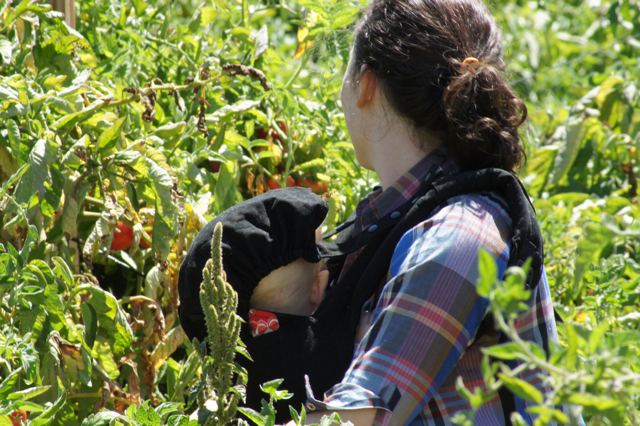


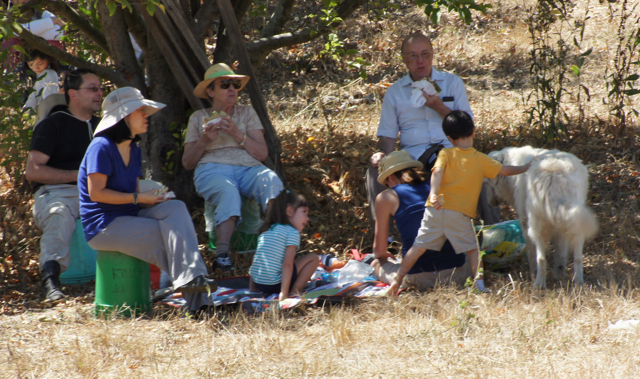


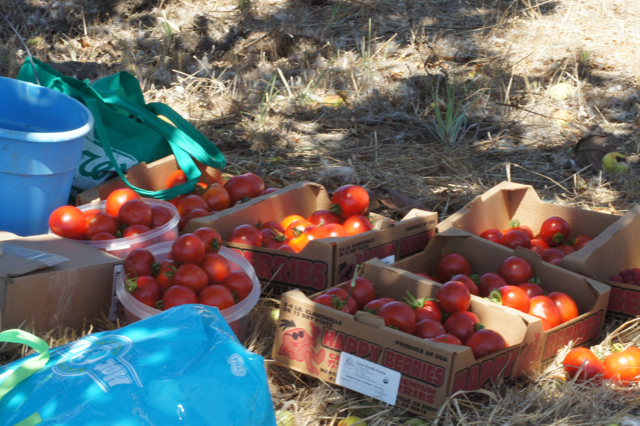






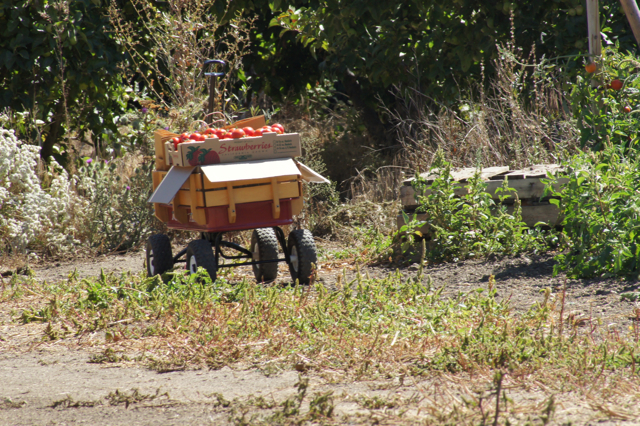
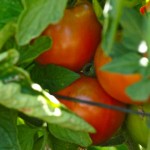 Crop & Field Notes: What’s in the Fields – July 2013
Crop & Field Notes: What’s in the Fields – July 2013
Summer is upon us, and crops like our dry-farmed tomatoes are on the verge of being ready for harvest. Check out all that is going on in the fields.

This dry-farmed tomato field is looking very different from when it had a cover crop in March (below).
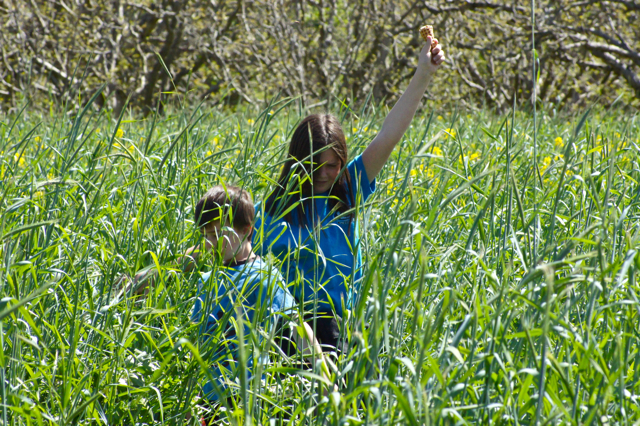
The cover crop was tall enough to get lost in during our Sheep to Shawl Event. Hold that ice cream cone high!
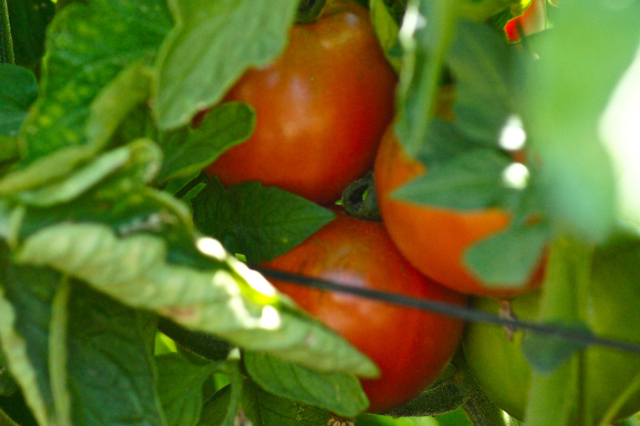
The very first ripe dry-farmed tomatoes can be found hidden among the lower leaves and branches.
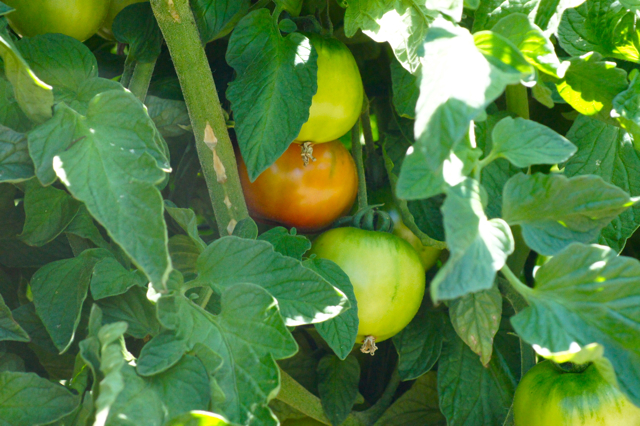
Most of the tomatoes are still green though, or just starting to turn red.

There is quite a difference between these March fields and the July ones, below.
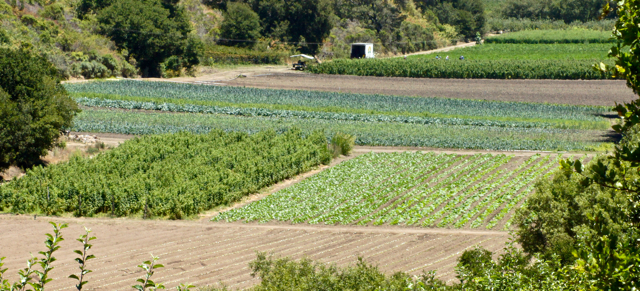
The raspberries (on the left) are green again, and the cover crops are gone – replaced by summer squash, kale, leeks, and chard.

The chard in this week’s boxes is most likely from the rows in the foreground, while the leeks in the back rows will be in future boxes.
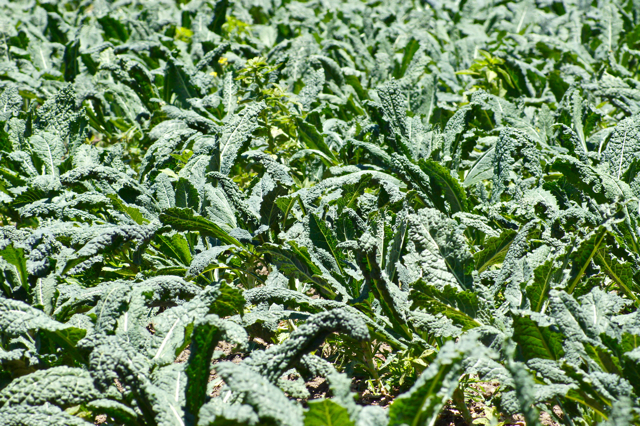
Dino Kale anyone? This crop is looking gorgeous!

Field of young summer squash.
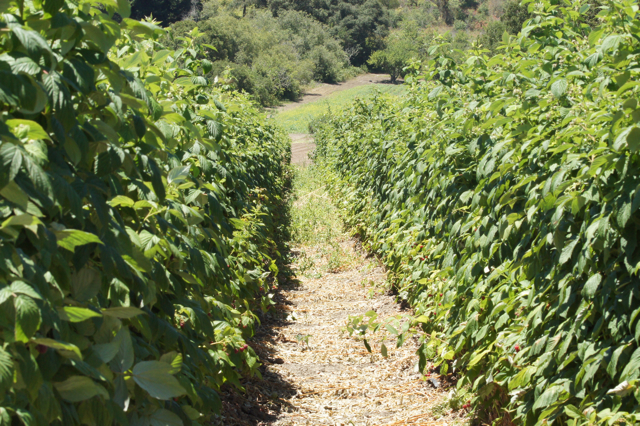
View from within the raspberry rows. You can’t see them, but the bees are busy buzzing among the raspberry blossoms.
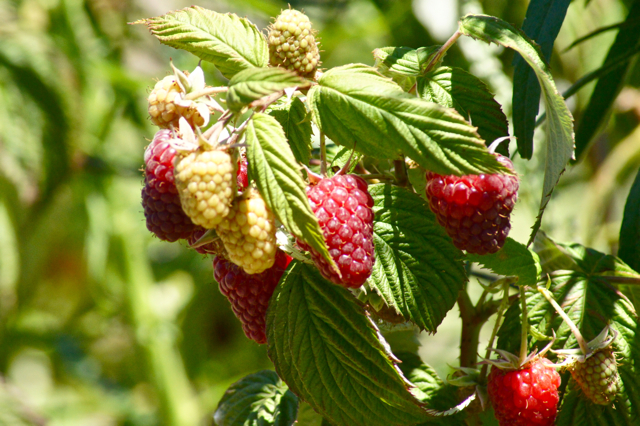
The raspberries are soooo gooooood!

And the blackberries are coming on strong, too.
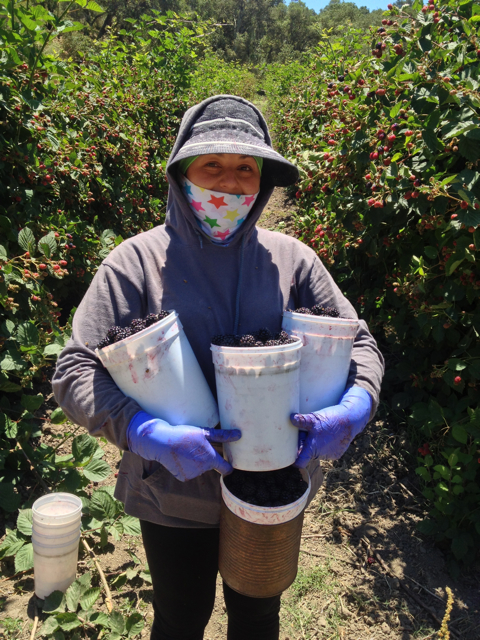
Here’s Adrianna with just the start of today’s blackberry harvest.
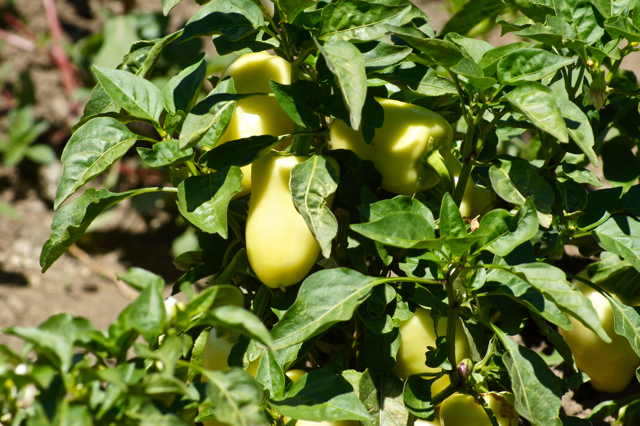
These yellow peppers….

… and these poblano peppers …

… and all this basil, are loving the heat we’ve been getting so far this season. Everything is ripening about two weeks earlier than last season.
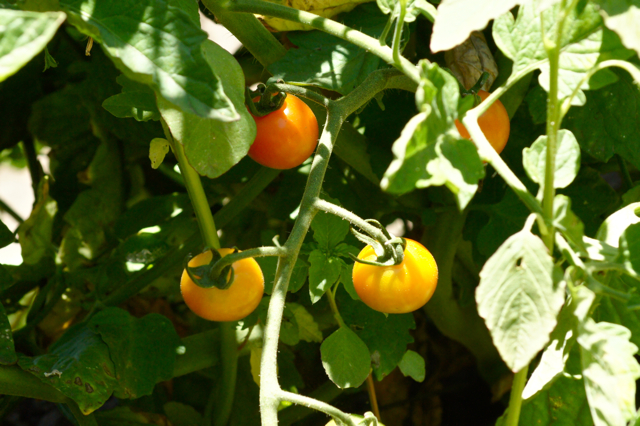
And we can’t forget about the cherry tomatoes. The first, small harvest is going to the Farmers Markets this week. They’ll be in the shares soon, too!

Nearly six hundred apple trees were grafted earlier this year. This one was grafted in February.
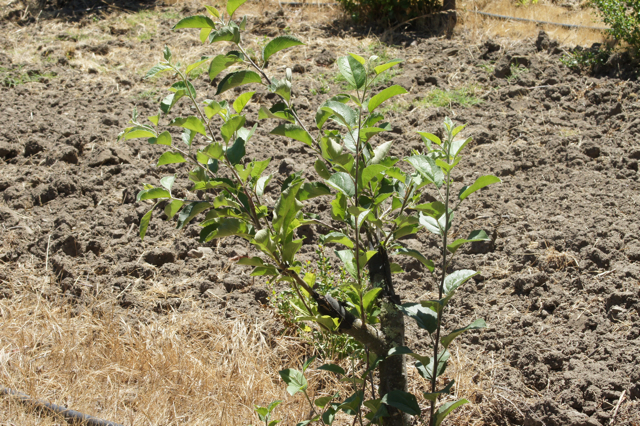
Now it’s leafing out, and will be producing apples in future seasons.

Here are some fujis ripening in a more mature orchard. They’ll be ready for harvest sometime in October.
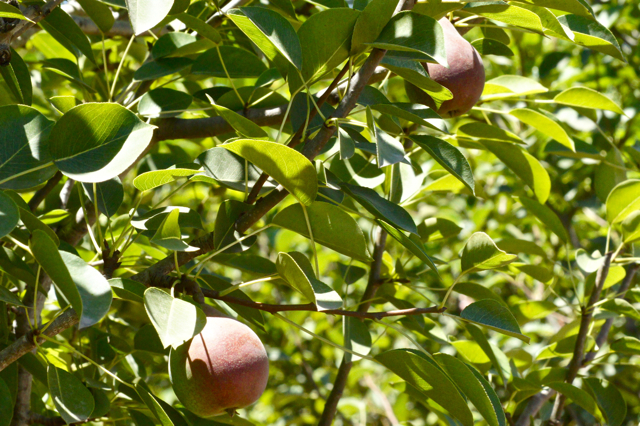
Warren Pears, which will also be ready for harvest in October or November, can now be spotted on the trees.
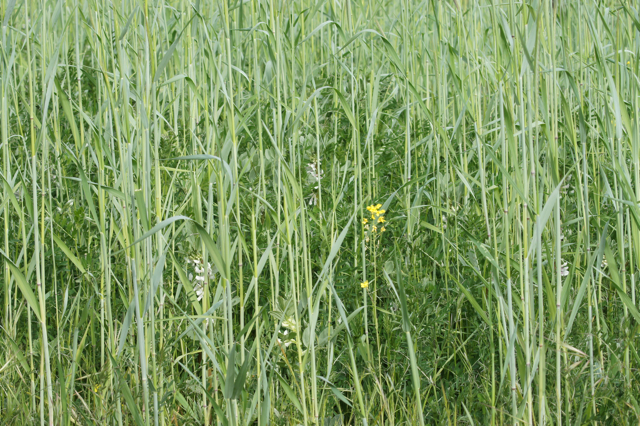
The cover crops in the upper fields (where Tom and Elisa played back in April) are now gone, replaced with…

… this corn field.
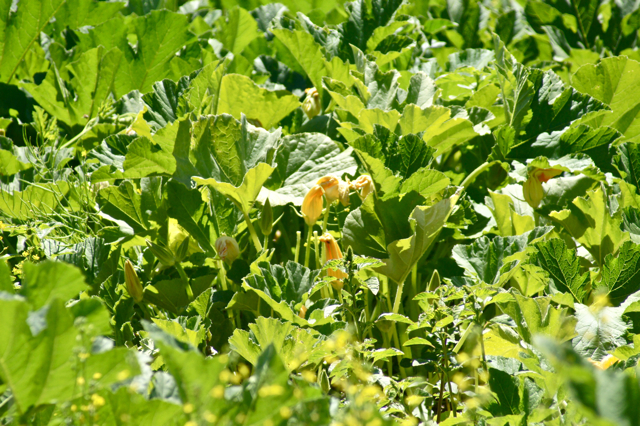
And last but not least, blossoms can be spotted in our pumpkin patch. Is it too early to mention Halloween?
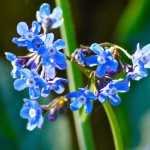 Springtime Blooms on the Farm – March 2013
Springtime Blooms on the Farm – March 2013
Although the infamous Food Drought occurs during March, there’s still a lot happening in the orchards and fields. Here are some pictures of the various things that are in Spring bloom for you to enjoy. (Originally posted in March 2013)
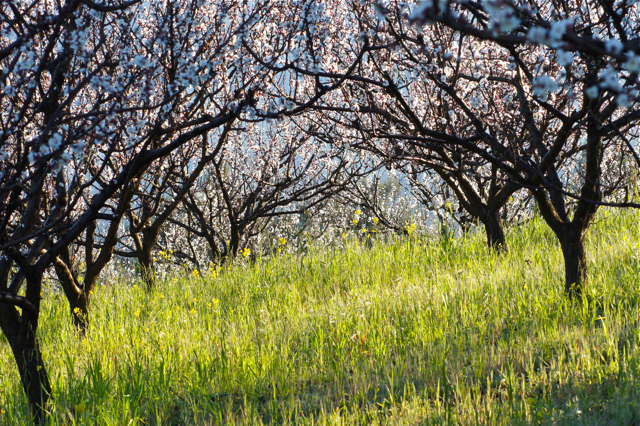
The apricot trees are a riot of blossoms exploding like popcorn right now. Though we need more rain, keep your fingers crossed it holds off long enough for proper pollination and fruit set to happen.
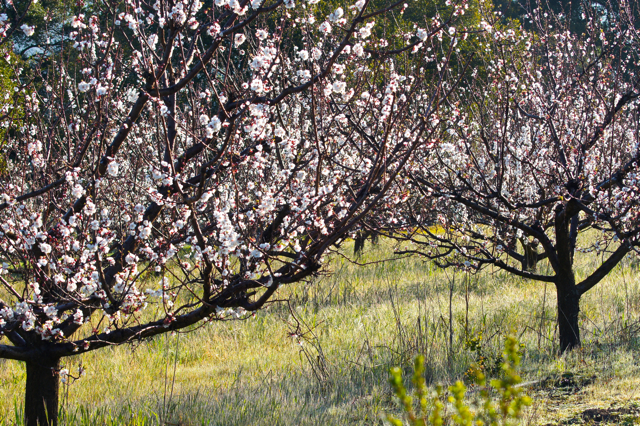
We dream of a bumper crop of ‘cots this season since we haven’t had one in years.
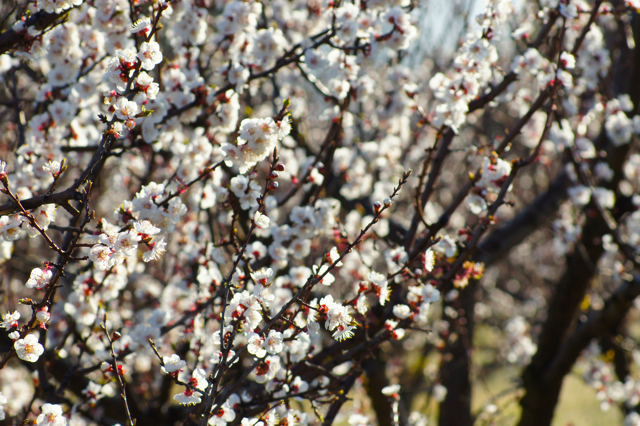
Apricots are self pollinating, which is why you won’t see many bees buzzing from blossom to blossom. The blossoms smell amazing though, and if we could, we’d add a scratch ‘n sniff to the picture for you.
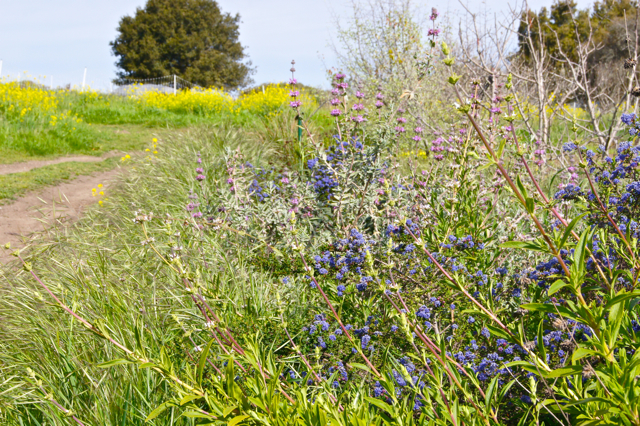
This is one of the many hedgerows planted on the Farm as part of a partnership with Wild Farm Alliance. This hedgerow contains ceanothus (California Lilac) and sage, among other native plants. There is a self-guided tour you can take that highlights more of these projects around the Farm.
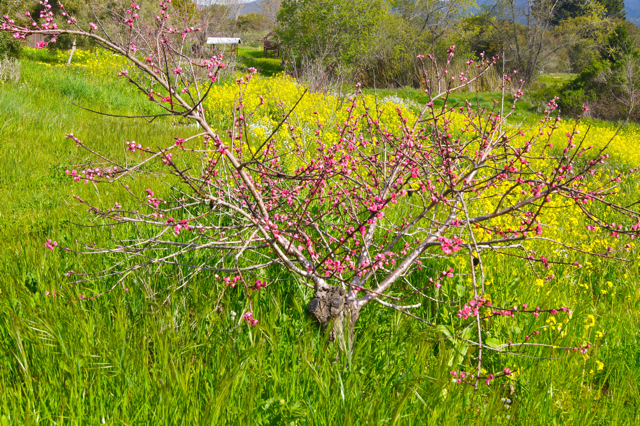
This beauty is one of the few peach trees on the Farm. We have few stone fruit trees since our coastal climate is too moderate for them to grow and produce well. They do much better in the inland valleys, like the San Joaquin, which get colder during the winter.
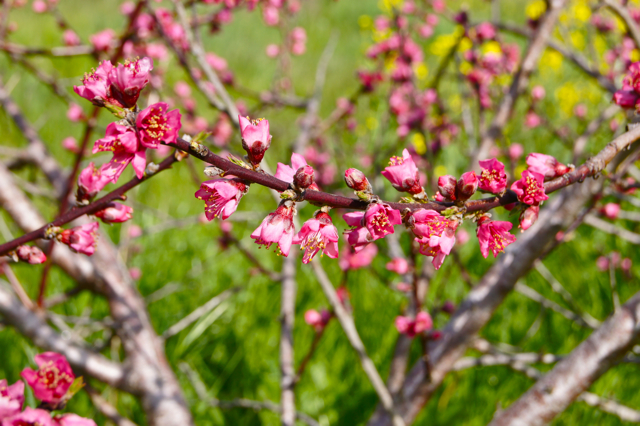
So close you can reach out and touch them.
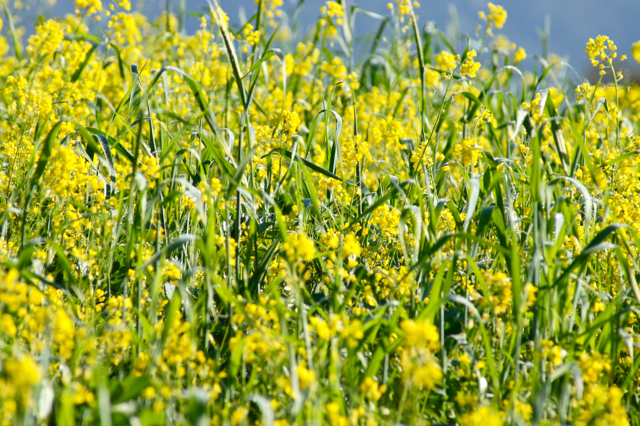
The yellow of mustard blossoms is a common sight in the cover crops we plant to recharge the soil and control erosion during the winter. Here it is competing with rye.
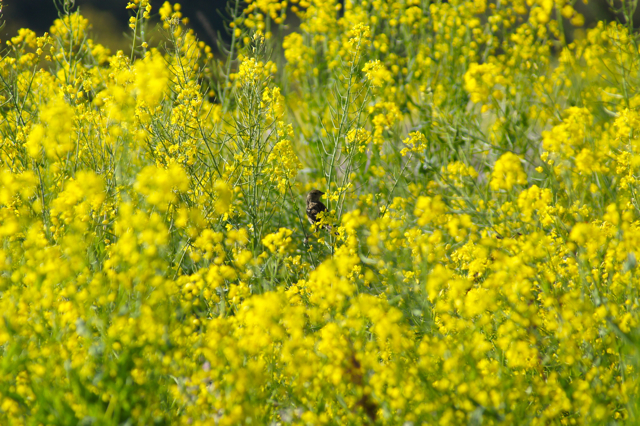
Mustard also provides cover and food for song birds during the winter. You may only see just the one, but you can be sure there are a dozen more hidden in there. They flutter and pop up like Jack in the Boxes as you walk past the fields.
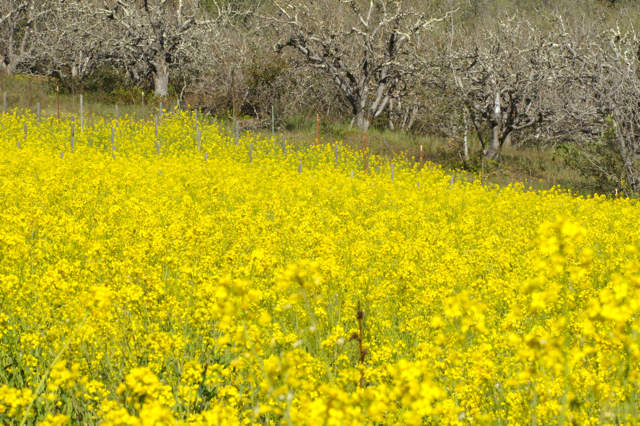
Mustard, originally planted among apple trees that were removed (you can see some of the remaining ones at the top of the picture), has taken over this sloping field where we grew dry-farmed tomatoes during the last Regular Season. Mmmm … dry-farmed tomatoes. Is it August yet?
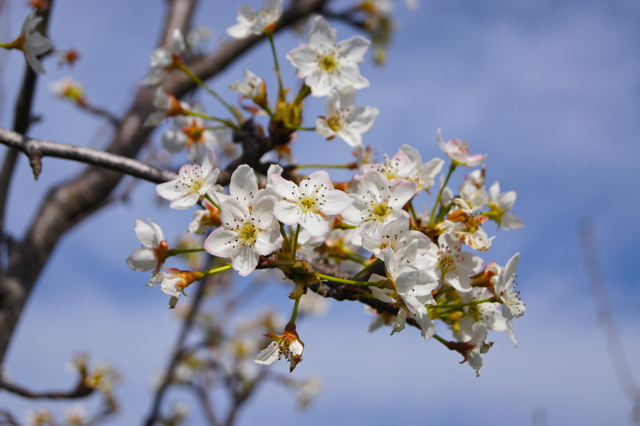
These are blossoms of an early blooming variety of pear tree. The trees that produce the Warren (French Butter) Pears that go in the shares have yet to bloom.
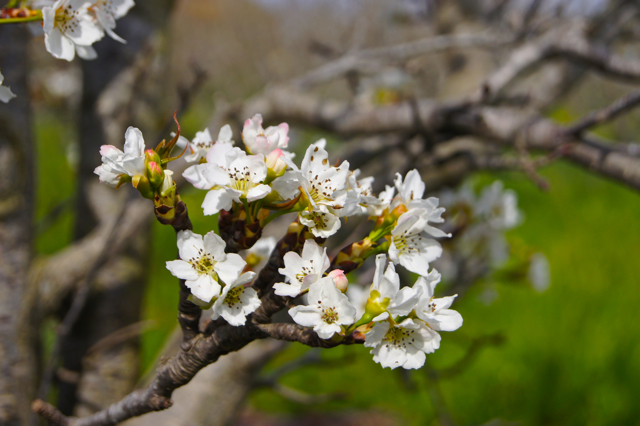
While pear blossoms look a lot like plum blossoms, there are differences. Notice the blush of pink at the tips of some of the petals and how dark the pollen is. Now, check out the plum blossoms in the next picture.
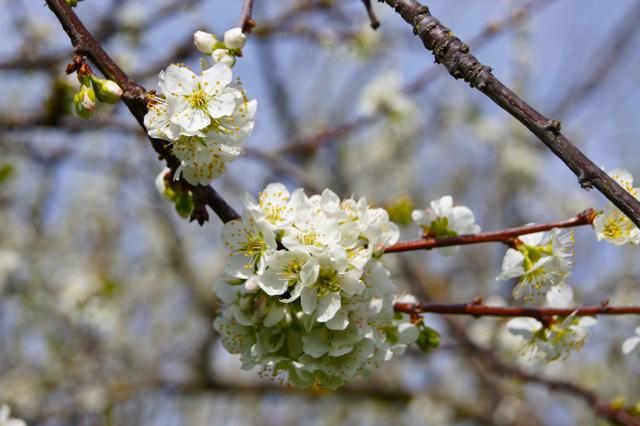
See how there’s no pink on the petals of these plum blossoms? The pollen is also yellow, rather than brown like on the pear blossoms above.
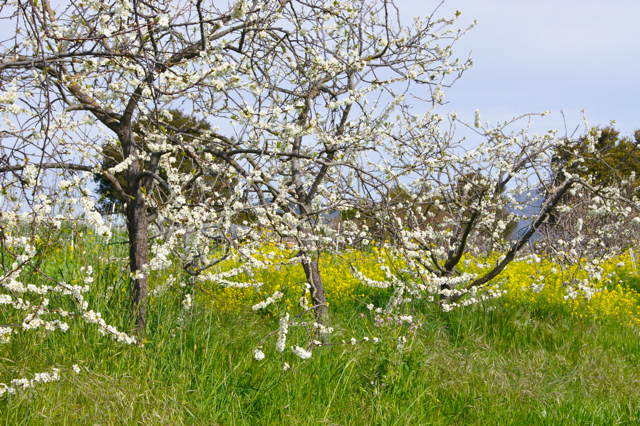
Plum trees have different growing patterns. Notice how the branches and trunks of these trees swoop around in curves.
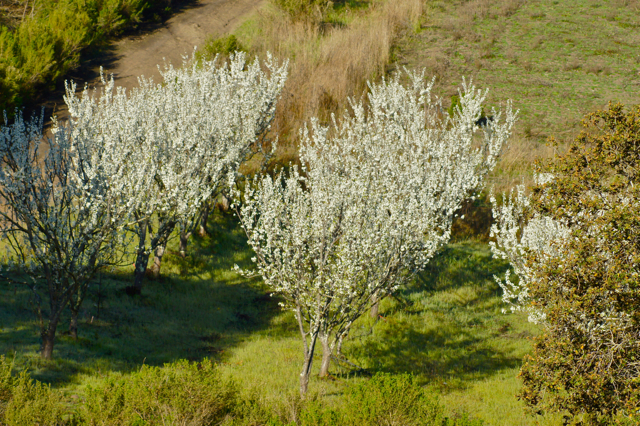
While these plum trees send their branches shooting mostly straight upwards.
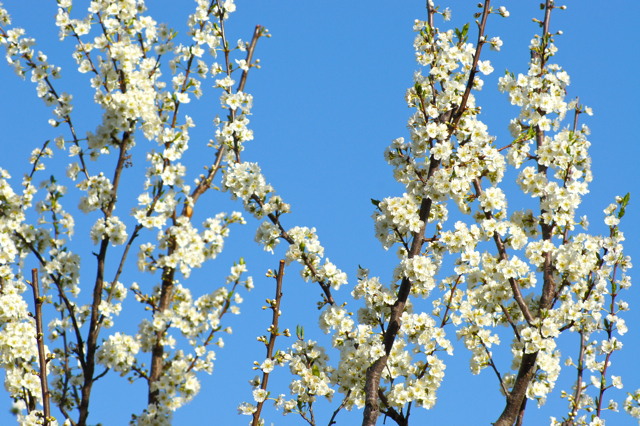
If you look closely, you can spot the places where the branches of this plum tree were pruned just a few weeks ago.
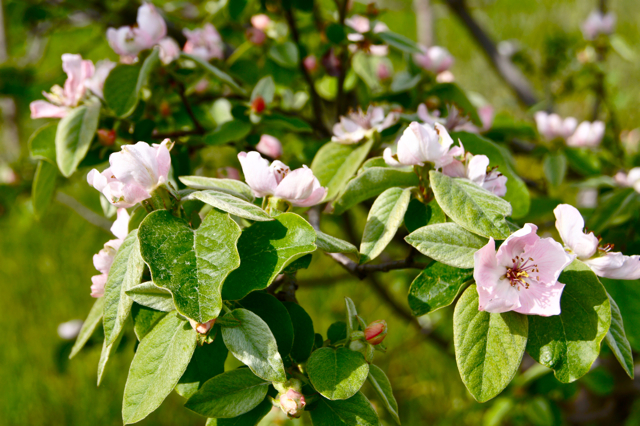
Quince trees make good root stock for pear trees to be grafted to, and that’s what these trees were originally planted for. Farmer Tom became fond of them, though, and decided to leave them as is. We’re so glad he did, because otherwise we wouldn’t have the quince candy (membrillo) their fruit gets turned into for us by Happy Girl Kitchen. This quince orchard is near Toasty 2, our cob oven that’s used during Community Farm Days to make things like pizza and apple tarts. Did someone just say, “Yum!”?
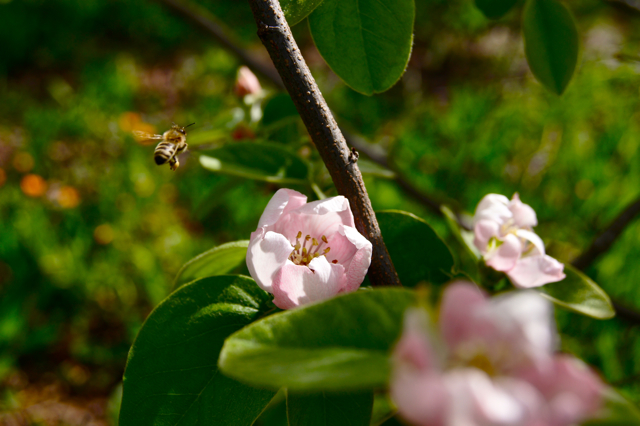
Unlike apricots, quince are not self pollinating, so it’s a good thing the bees love them. Here’s one coming in for a landing now.
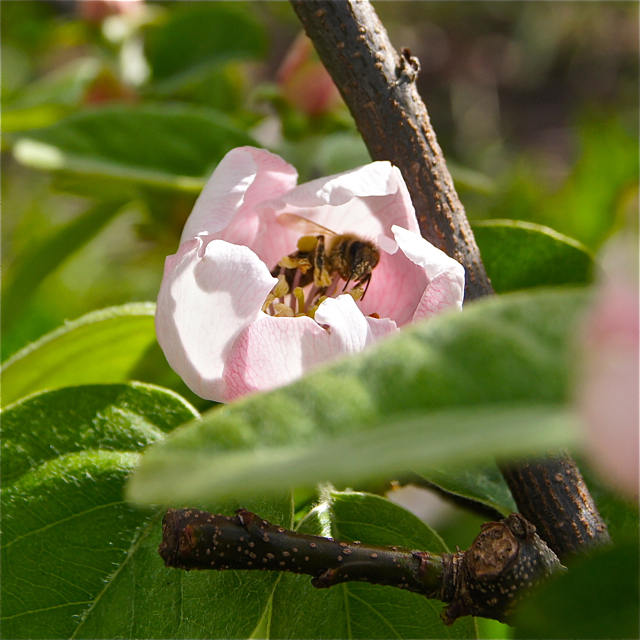
It’s great how the quince blossom acts like a cup to keep the bee inside as long as possible to ensure good pollination.
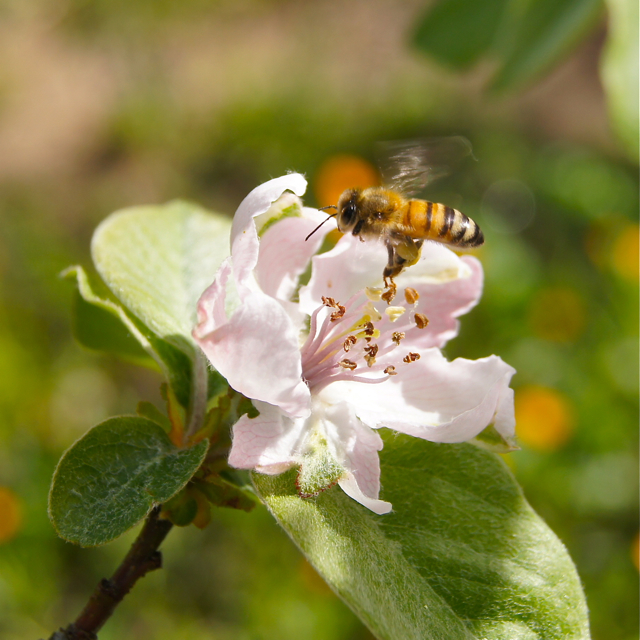
Notice the “peach fuzz” on the leaf below the blossom. This same fuzz covers the quince fruit itself which is pear shaped, so imagine a fuzzy pear and you’ll have a good idea of what’s to come after this bee does her job.
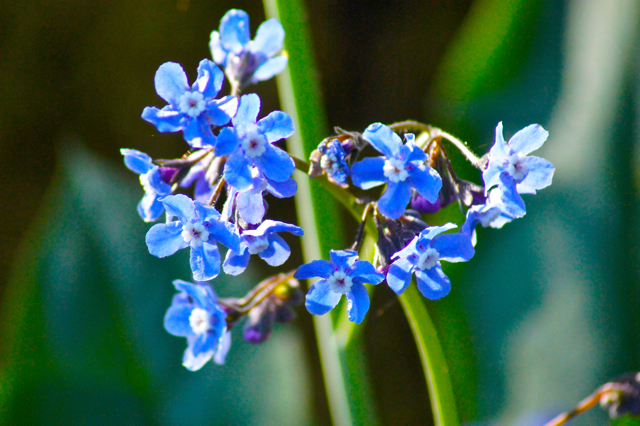
At the very back of the Farm is a short wild-land trail where native wild flowers like this Western Hound’s Tongue can be found growing under oak trees near groves of redwoods.
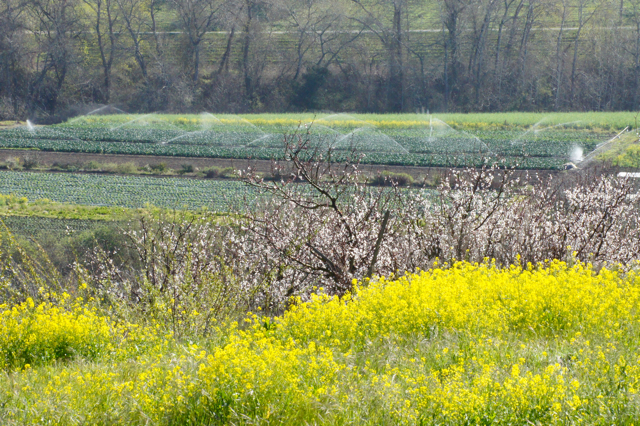
This picture captures a patch of mustard in front of one of our apricot orchards on a hillside above the lower fields where we are growing veggies that will soon be in your share box.
Community Supported Agriculture, whether receiving a share or going to a Farmers Market, is the best way to ensure a farm like ours thrives and continues to provide a place for natural organic diversity.
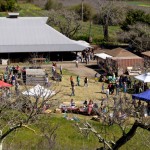 A Look Back Over the Year – Jan 2013
A Look Back Over the Year – Jan 2013
Participating in the Farm’s CSA program and receiving a weekly share gives us the chance to experience the seasonal nature of the harvest over the course of the year. Participating from year to year provides an even broader perspective of how nature changes the harvest from one year to another.
Here’s a look at what 2013 was like (click on highlighted text to reach an associated post) –
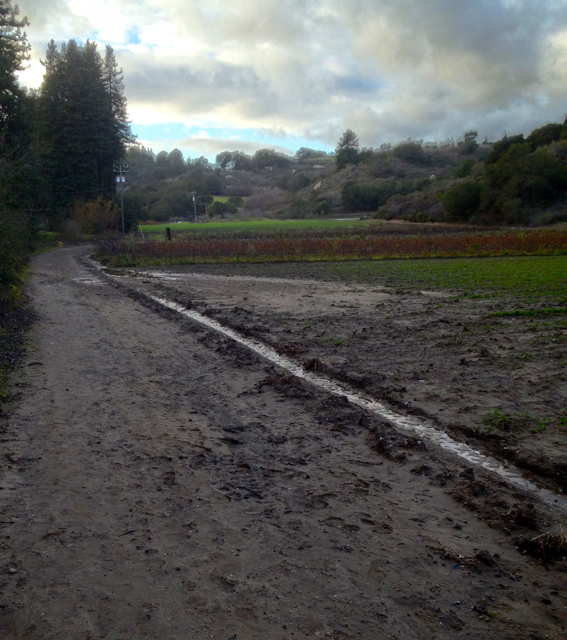
Unlike the lack of rain we are currently experiencing, last year began with storms which flooded part of our Lower Fields. By chance, the flooded area was in part of the fields planted mostly with cover crop.

Though there are apples from the previous Fall harvest in cold storage, January is the time when the trees themselves are dormant. This is when the trees were pruned in preparation for their next crop.
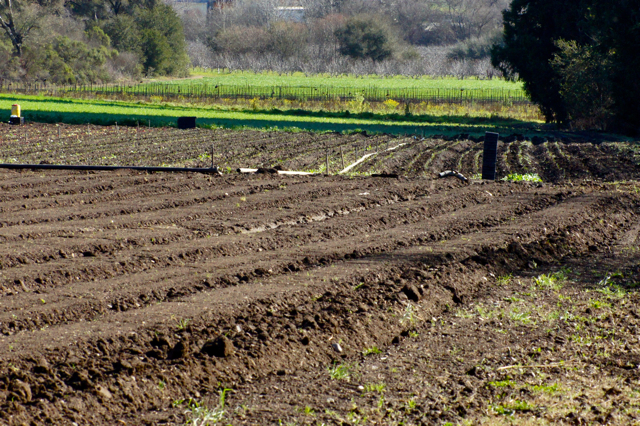
As the fields became dry enough, rows could be formed for new plantings. The green of cover crops just sprouting can be seen in the background, while the field in the mid-ground is full of transplants, and is pictured in other posts in July, August, and December.

Planted at the end of the previous year, cover crops go through their own progression. Pictured here are February cover crops in the Upper Fields. The mustard just beginning to bloom, while the rye and legumes have yet to reach full height.
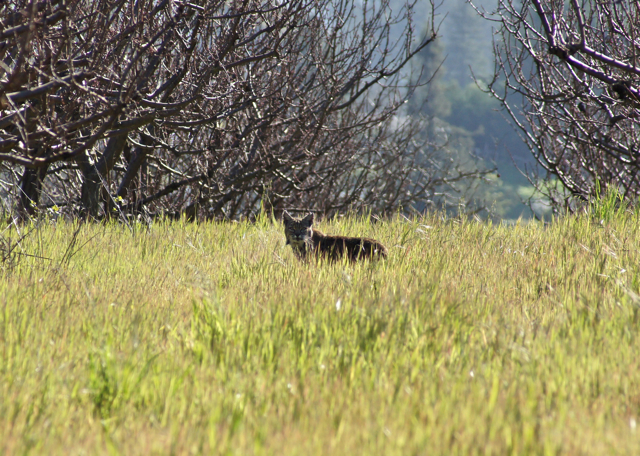
While cover crops are planted in the fields, the orchards have their own carpet of grasses in February which are just tall enough for a bobcat to hide in.
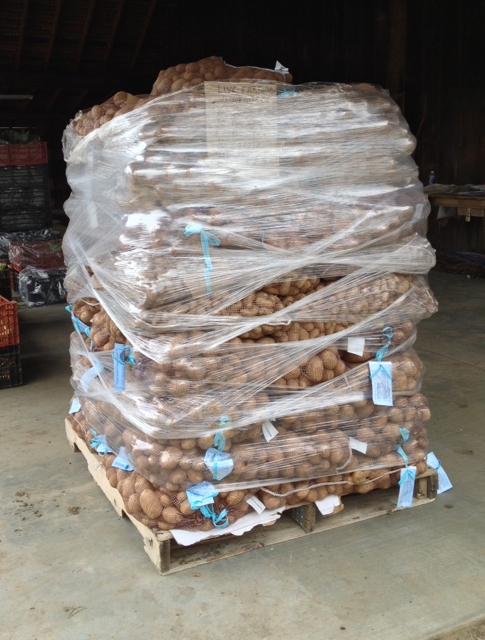
Preparations for crops that will be harvested during the upcoming Main Season are made in February. These seed potatoes arrived in mid-February.

Dormant since November, late February is when the apricot trees begin to bloom as well. Beginning as tiny buds, it only took a couple of weeks until the blossoms burst forth (below).
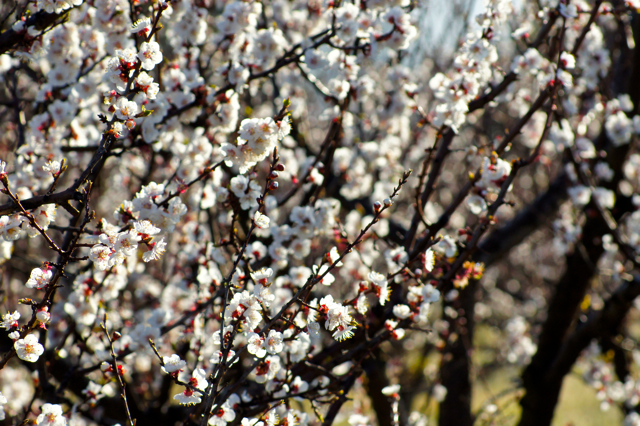
By mid-March the apricots were in full bloom. And they weren’t the only thing blooming on the Farm.
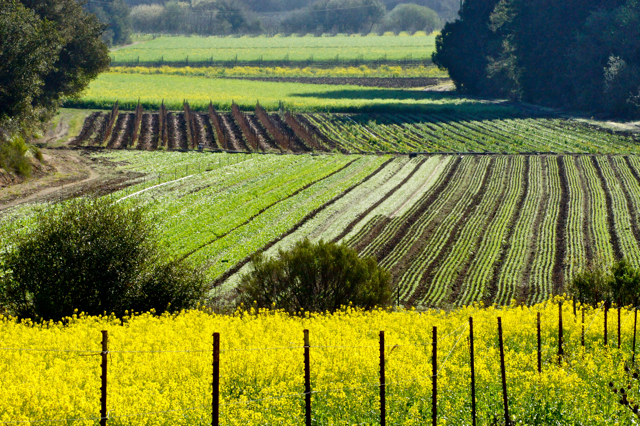
The fields themselves can change very rapidly. These are the Lower Fields in mid-March; the rows that were bare dirt in mid-February now covered in seedlings.

And here are the same fields less than three weeks later. Notice how much the crops grew with the returning sunlight and warmth as Spring arrived.
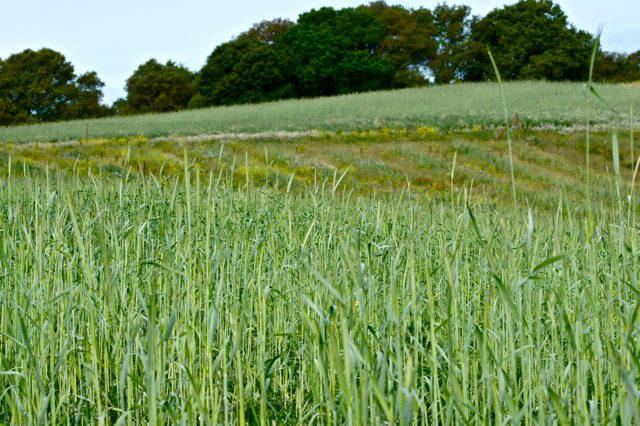
These are the same cover crops pictured above. It’s the end of March now, and you can see how the rye overtook the mustard. The cover crops stayed in the fields another couple of weeks. Long enough for Tom and Elisa to have some fun in them.
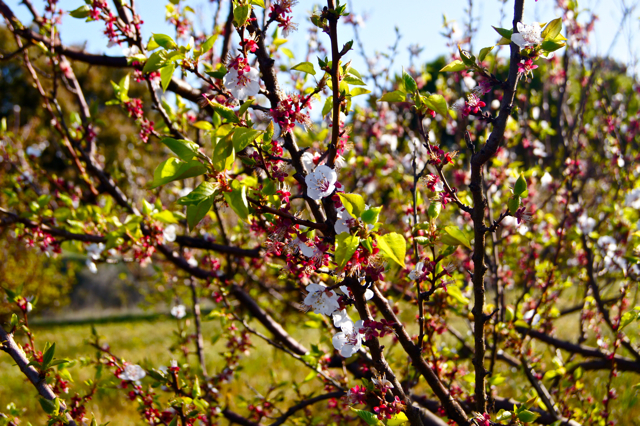
During the last half of March, the apricots went from bearing just blossoms to having a mix of blossoms and leaves.
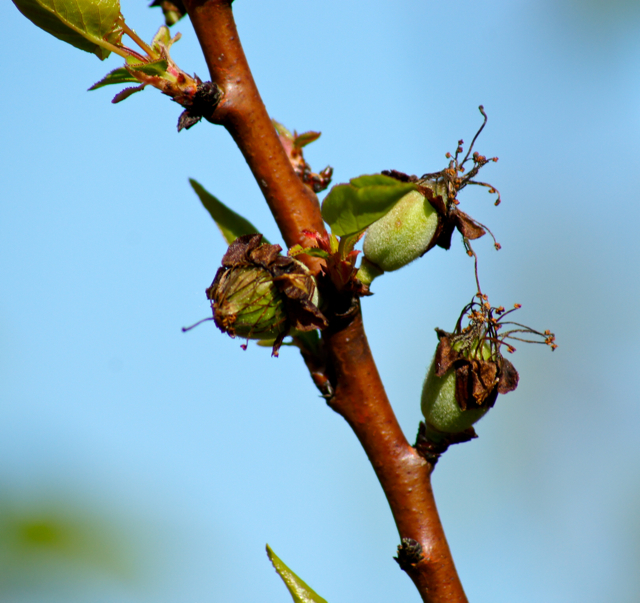
And by the end of March, small apricots were appearing. This is a critical time since the growing apricot has to shed the brown remains of the blossoms (called the jacket). Otherwise, the jacket can trap moisture and encourage a certain fungus to grow which damages the maturing apricot.
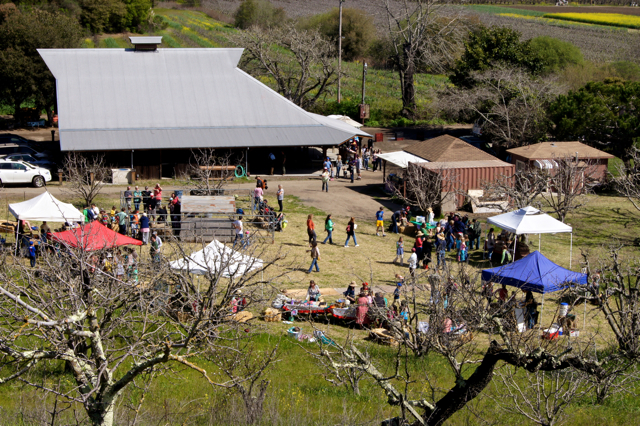
At the end of March we held our 4th Annual Sheep to Shawl event. The Lower Barn and surrounding area were prepped for throngs of people hoping to glimpse the sheep shearing, make some cool crafts, and eat some delicious food!

April is the beginning of Spring and our Main CSA Season. Green was the primary color as leaves burst forth on the trees.

As is typical, though, with our coastal weather, April began mostly foggy. The hens in one of our flocks were out and about enjoying the mild day. They had to be wary though …

… since the low fog kept a red-shouldered hawk roosting nearby, until the day cleared enough for it to look elsewhere for prey.
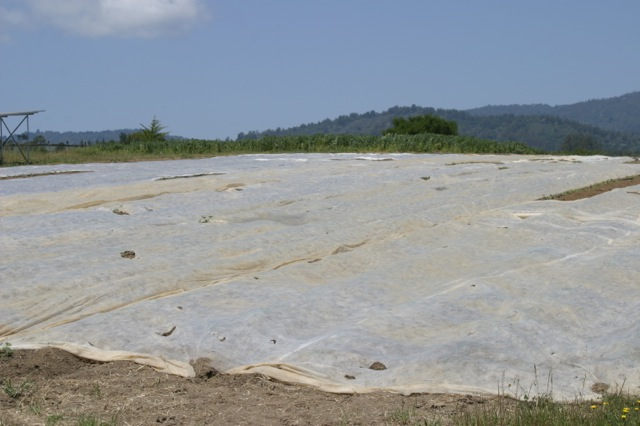
The end of April brought a touch of frost, and the need to cover recent dry-farmed tomato transplants and other vulnerable crops.
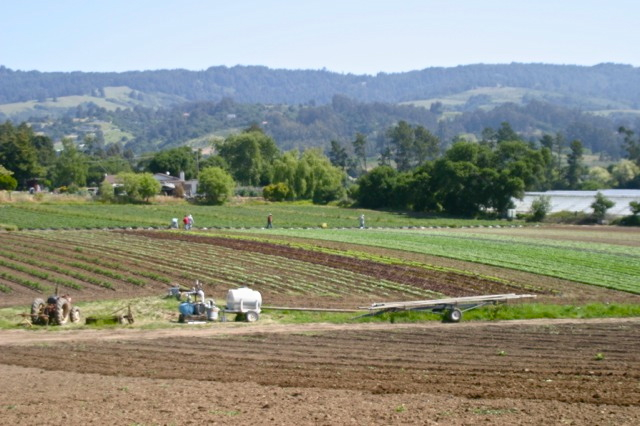
Though the year had begun wet, there hadn’t been much more rain and by May we were having to irrigate the fields and, unusually, many of the orchards. Pictured here is the main farm pump, and irrigation pipe ready to be placed in a recently planted field.
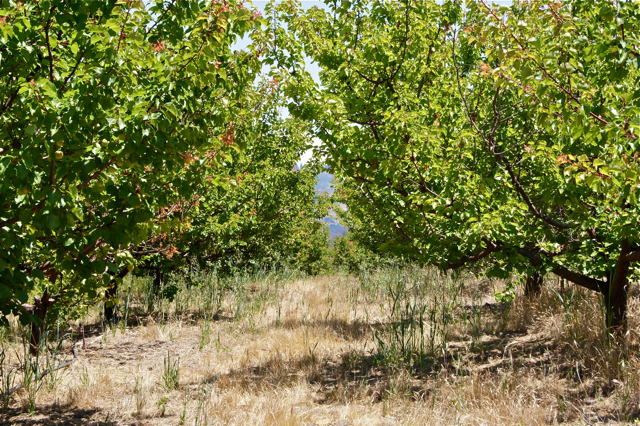
By the end of May the apricot leaves were looking hardier in preparation for summer. In contrast, the once green grass was already brown.

The apricots themselves were plumping up nicely. It was shaping up to be a bumper crop.
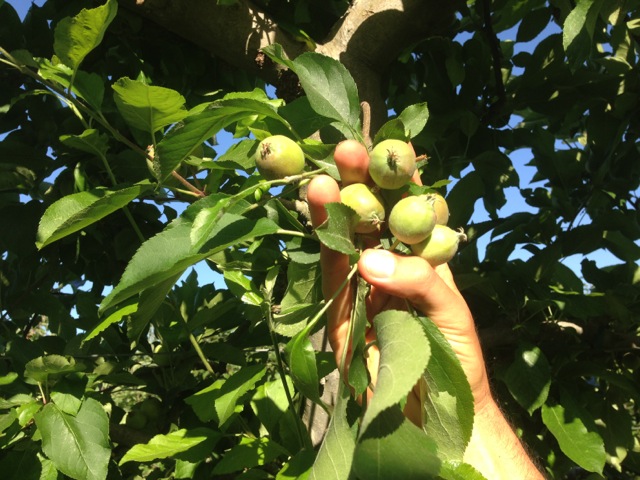
Meanwhile, along with many other things happening in the fields, it was time to thin the apples in order for the remaining ones to reach a large enough size. This bunch would be thinned down to two or three.
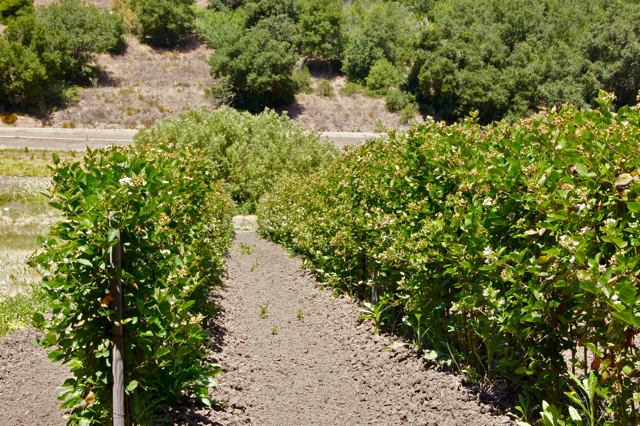
By the end of May, the blackberry vines were covered in blossoms.

Blackberry blossoms are a wonderful combination of white and pinkish purple. Looking almost tie-dyed.

June is the month when certain field crops, like crucifers, are tapering off and fruit, like the Santa Rosa plums pictured here, are ripening. It’s a transition time from Spring to Summer.
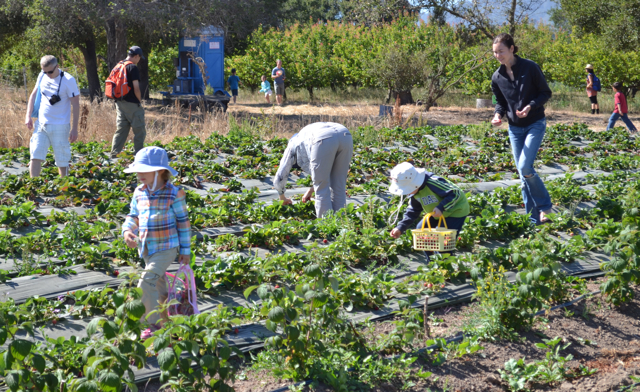
Our 18th annual Solstice Celebration was alive with joy and excitement. It was probably one of the best attended, and many visitors could be spotted harvesting strawberries from our Discovery Program garden prior to the evening potluck and bonfire.

The end of June was all about the Blenheim apricots. As we’d hoped, it was a bumper crop and we were able to hold a U-harvest day for CSA members to come and share in the bounty.

In July, the raspberry field in the middle-left of the picture looked very different from what it looked like in the pictures above from March. Leafy and green, the vines were now producing berries. More raspberry vines can be seen in the upper right corner.

As much as farmers do their best to keep crop production consistent, every year still brings its own differences. While the raspberries were wonderful, due to unfavorable weather conditions there weren’t as many this past summer as there have been in previous ones.

It was an abundant summer for blackberries, though, which stepped in to fill the gap left by the smaller raspberry harvests.
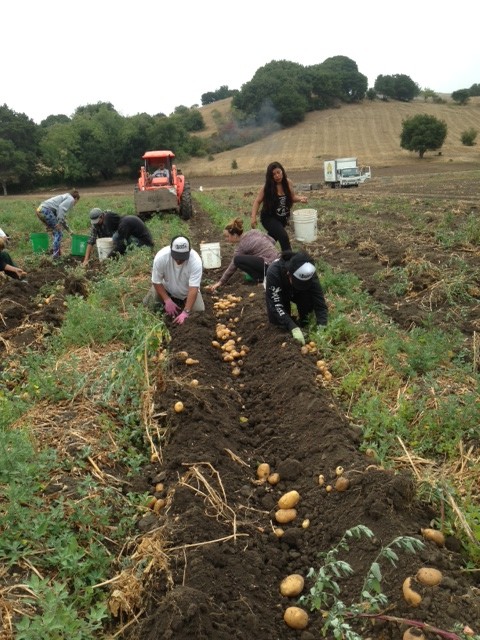
The Farm also serves as a classroom, and this past summer it hosted a teen program by Food,What?! The help could not have been more appreciated as the season approached its peak.
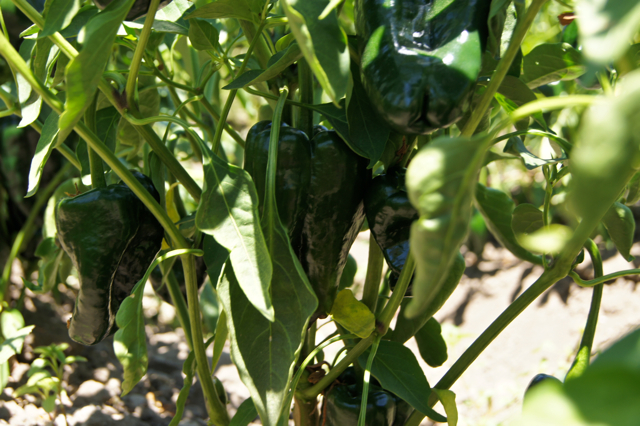
The end of July brought consistently warm days, and heat loving crops like these Poblano (often called, Pasilla) peppers sized up nicely. It was a very active time on the farm, with crop variety increasing almost daily.
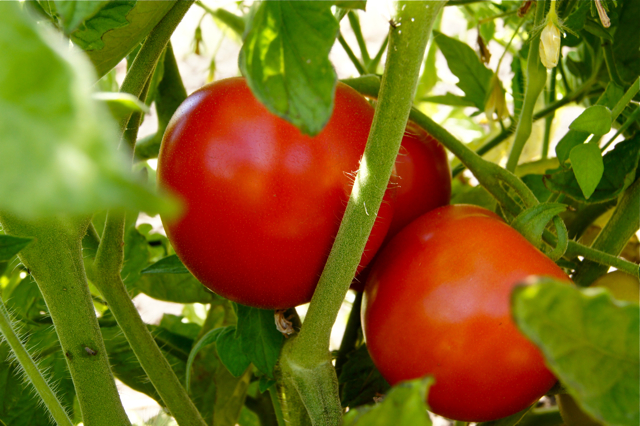
The first week of August brought a field visit from County Supervisor Kaputt, and it also brought the first dry-farmed tomatoes.

The summer squash field above was an abundant producer during August. The pickling cucumbers were in a nearby field.

While August crops were maturing in the fields, seedlings were being started in the greenhouse to stay on the planting schedule so there would be veggies to harvest in the upcoming months.
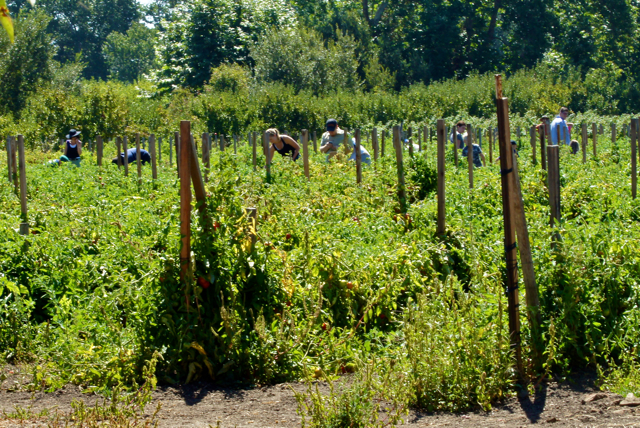
At the end of August, it was time to invite our community to the Farm for the summer’s first dry-farmed tomato u-harvest. We had a couple more scheduled u-harvest days, and the community field was open on Saturdays for harvesting all the way through October.
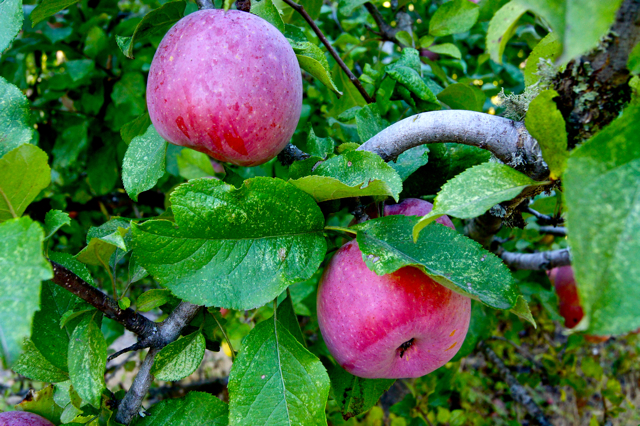
Tended to all year long, some apples were ready to harvest at the end of August while the majority of the apple varieties grown on the Farm, like these Fujis, were ready sometime during September and October.
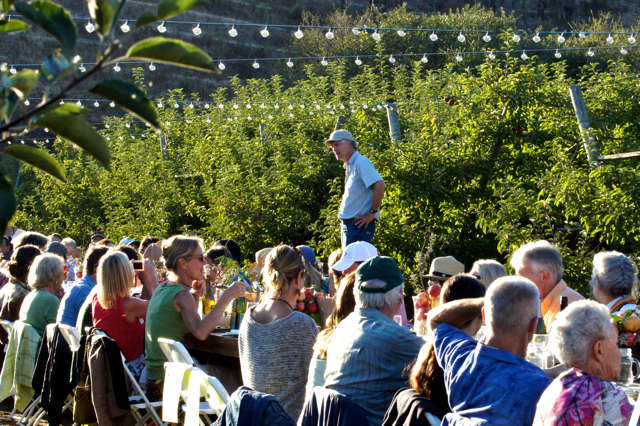
The Farm’s annual fundraiser for its Discovery Program was held in mid-September. The event, Slice, celebrated the apple harvest and was a great success, exceeding the year’s fundraising goal.

It rained a little, just before the Equinox. Not enough to make a difference in whether we needed to irrigate or not (we still did), yet it washed the dust off everything for the change of the season.

October was ushered in by the harvesting of our pumpkin patch, reminding us we needed to prepare for our Fall Harvest Festival at the end of the month.

Like June, October is another transition month. There was still a large variety of crops available or becoming ready, like this Romanesco cauliflower which creates a nest of leaves in which the head will mature.
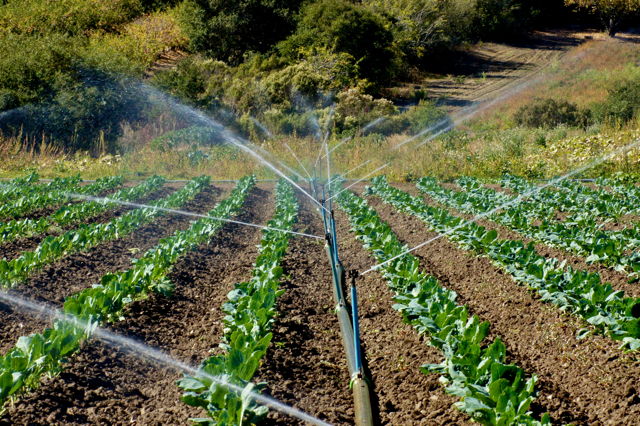
With no rain predicted in October, we were still irrigating fields like this one of Romanesco. This is the field that summer squash was growing in during August. Just beyond is the cucumber field, now covered in weeds and waiting to be plowed and planted with lettuce seedlings.
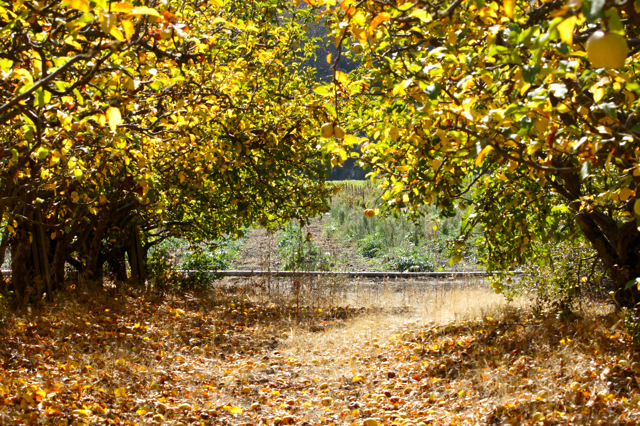
The angle of sunlight increases after the Equinox, and it takes on a golden tinge that triggers a response in the leaves of trees like these apples, causing them to yellow and fall.
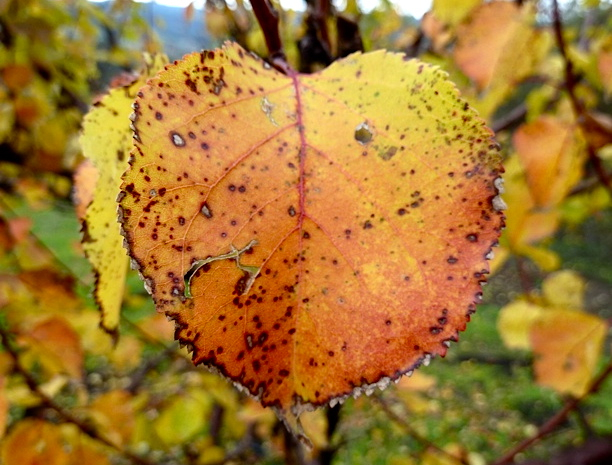
The Farm’s Main CSA Season ended in mid-November. Plant growth was slowing as colder days arrived with the approach of winter, and the fruit trees entered their period of dormancy. We began now to look to the beginning of our Winter Season at the end of the month, and further ahead to our next Main Season.
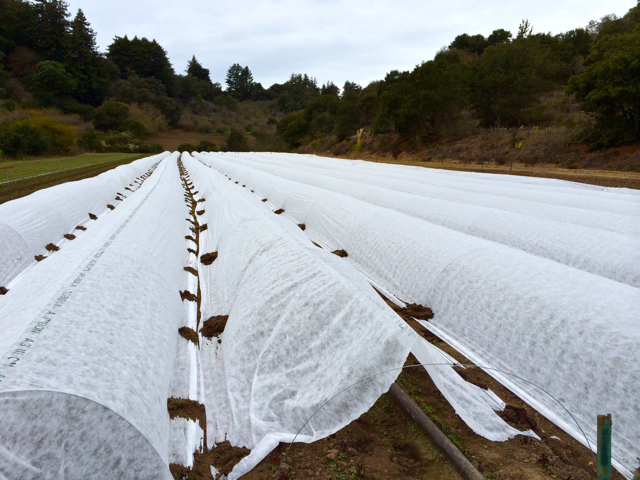
Reminiscent of the end of April, frost was predicted at the beginning of December. Once again, delicate crops like the lettuce in the field above were covered to protect them from frost damage.

April’s frost was light and quick. December’s was heavy and occurred on a number of nights in a row. This is the field of Romanesco that was being irrigated in October. With growth slowed, the heads may not be ready to harvest until late January or early February.
This has been just one year in the life of Live Earth Farm. We want to thank all those who have participated in our Community Supported Agriculture program over the past 18 years. The Farm would not exist without the support of its community. As the Farm begins its 19th growing season, all of us here are dedicated to continuing to provide our community with the best organic produce possible, and to maintain the connection made between you and the source of your food.
[button link=”http://liveearthfarm.net/?p=47373″]About our CSA Program[/button]
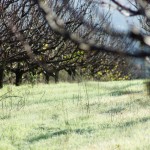 Winter on the Farm – Dec 2012
Winter on the Farm – Dec 2012
Our CSA program is on its 4-week 2012-13 Winter Delivery Break – while there may be no veggie boxes for a few weeks things are still (quietly) happening in the fields, as some plants bolt forth and others go into retreat. Here are some pictures from around the farm for you to enjoy.
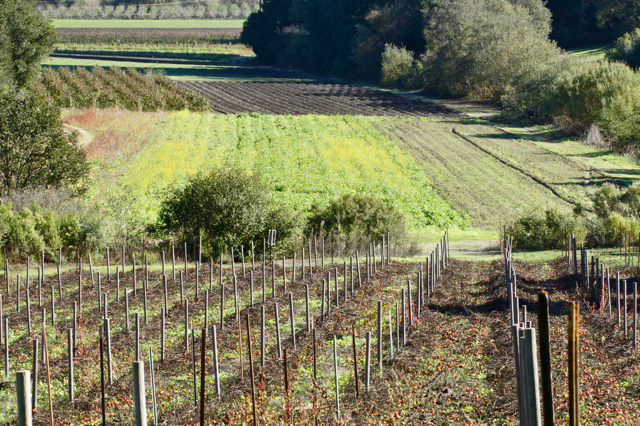
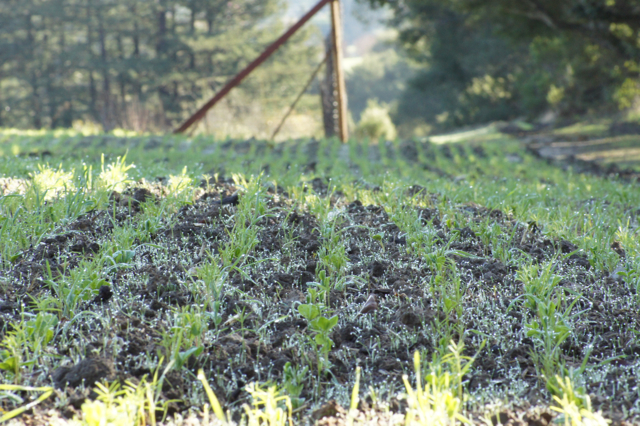
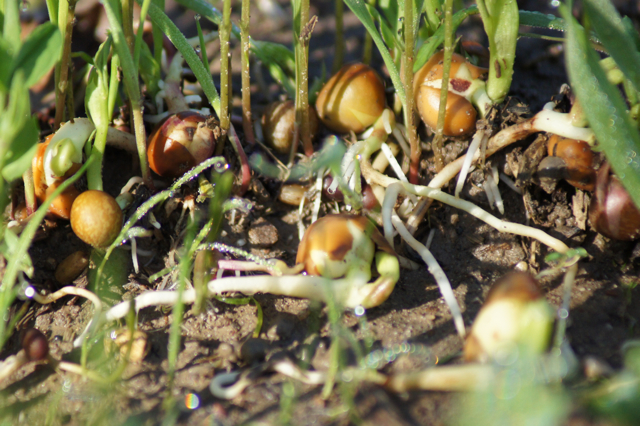
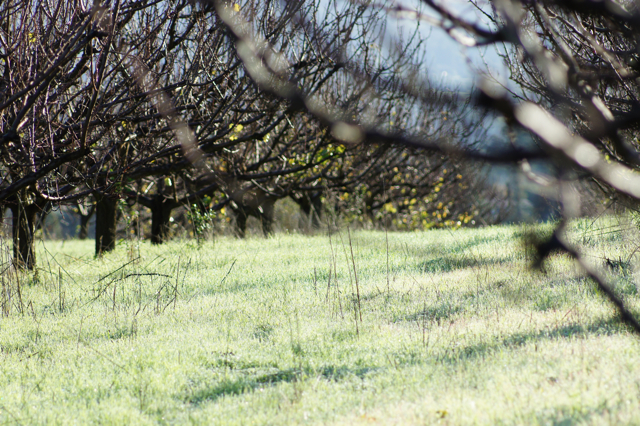
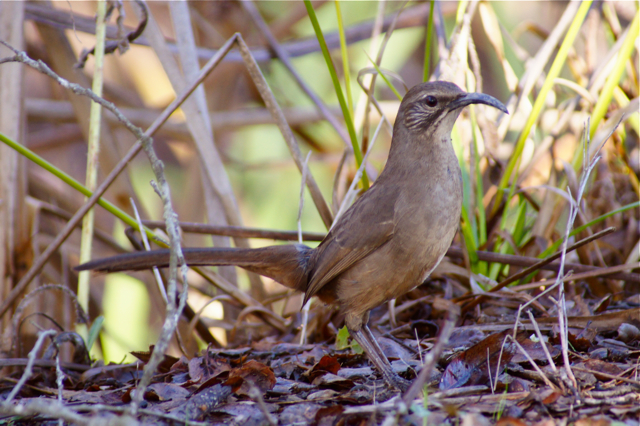
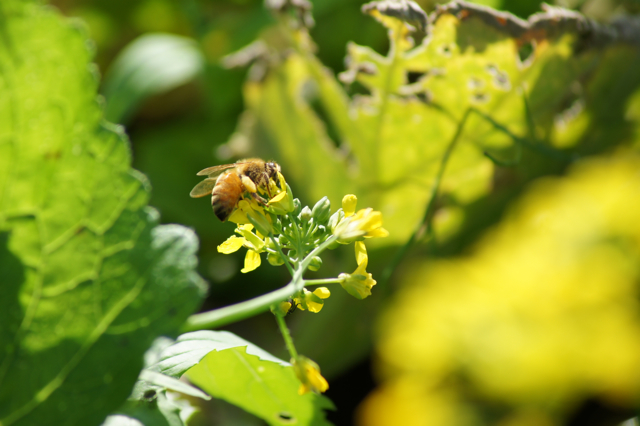
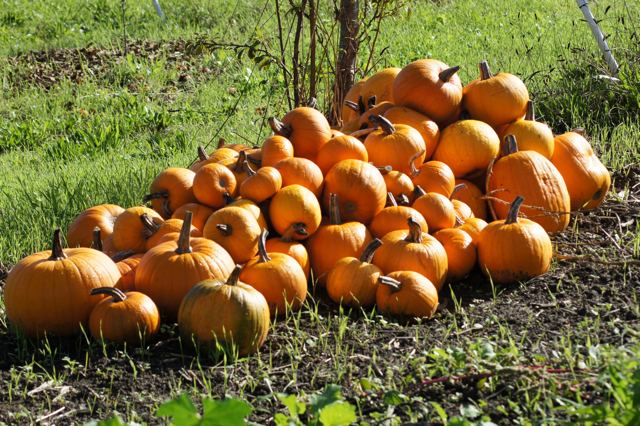
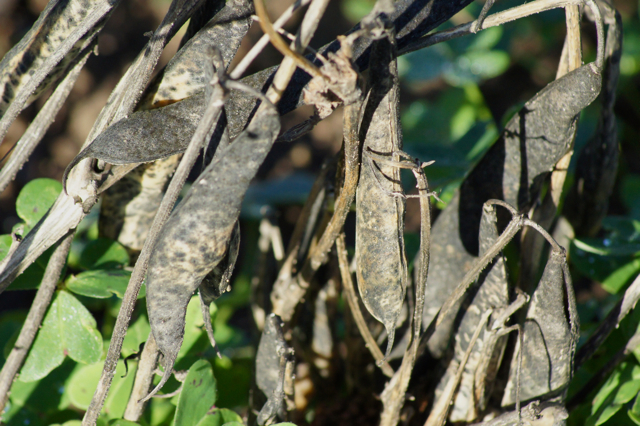
Ingredients:
2 tablespoons butter
¼ cup almonds, coarsely chopped
8 carrots, coarsely chopped (6 cups)
2 bay leaves
2 whole cloves
1–inch piece stick cinnamon
Juice of 4 oranges
1 cup heavy cream or coconut milk
Directions:
1. In a large pot melt the butter. Add the almonds, onions, carrots, and sauté until the carrots start to become tender. Add water to cover, the bay leaves, cloves, and cinnamon stick. Simmer, partially covered, for about 15 minutes, or until the carrots are soft.
2. Allow the carrot mixture to cool. Remove the bay leaves, cloves, and cinnamon stick.
3. Blend the carrot mixture with orange juice and cream in a blender. Dilute to a good consistency with more orange juice, if desired.
4. Chill thoroughly. Taste, season and serve garnished with a dash of thick cream or coconut milk.
Serves 6

